Cool Green Science
Stories of The Nature Conservancy

The Yeti: A Story of Scientific Misunderstanding
Science has laid to rest any "evidence" of the Yeti, but perhaps it has always overlooked the myth.
Share this article
Share this:.
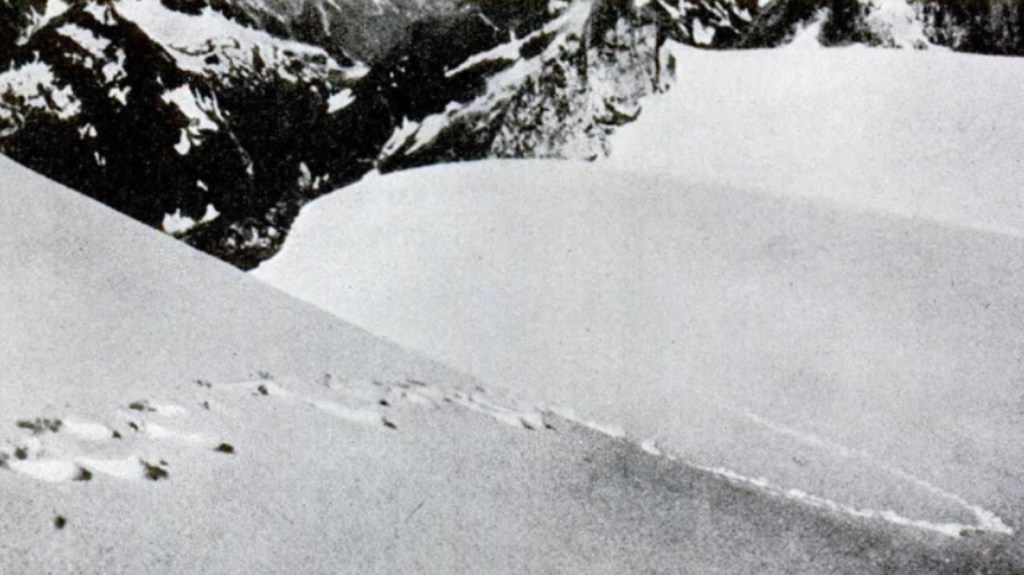
The Yeti is a cryptozoological phenomenon popularized in the early 20 th century by British mountain explorers in the Himalayas.
Those who claim to have seen it report a modest-sized, two-legged, hairy mountain creature with disproportionately large feet.

A recent scientific study has shown, once and for all, that physical evidence (fur, bone and skin) purported to be from the Yeti are instead from bears, based on genetic analysis.
Bear species that fall within the “range” of the Yeti include Asiatic black bear and two subspecies of brown bears, the Tibetan and Himalayan.
The reports of Yeti sightings began as soon as Western explorers made headway into the Himalayas. The explorers gathered first-hand accounts from locals and translated these observations into prosaic descriptions of the creature’s shape, fur color and gait.
With this, the Western world began to believe that the Yeti could be real, and Yeti-finding expeditions were dispatched.
Over the decades, Yeti encounters continued to accumulate, though physical evidence has always been elusive.
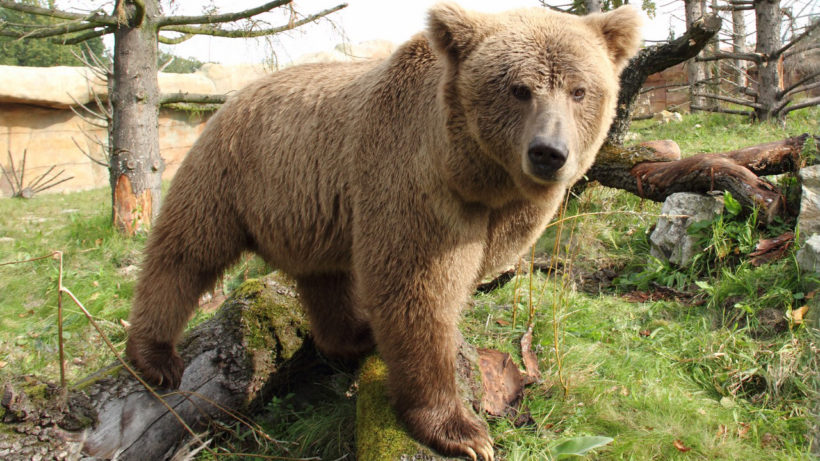
Nonetheless, the existence of the Yeti could never be ruled out. The Himalayan wilderness seemed vast and inaccessible enough for the existence of an undiscovered animal to be plausible.
In his book The Snow Leopard , famed nature writer Peter Matthiessen writes about a 1973 Himalayan expedition to study the blue sheep. Throughout his narrative, the author seems just as primed to spy a Yeti as he is a snow leopard. And we read that his companion, legendary wildlife biologist George Schaller, also refuses to rule out the Yeti’s existence.
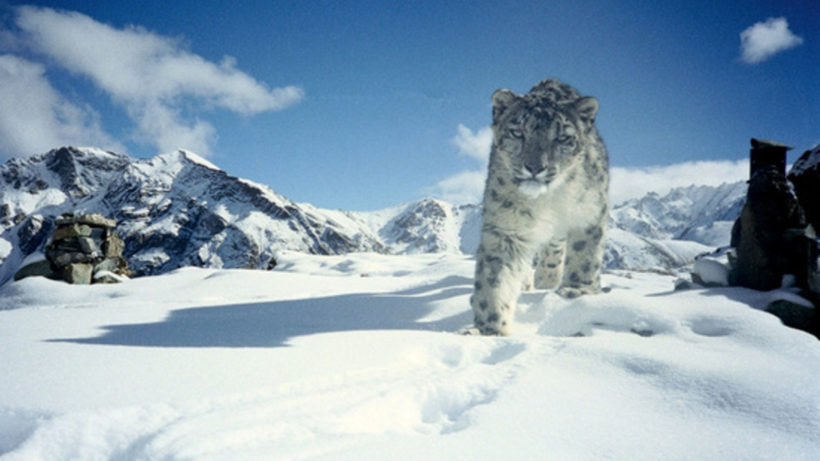
Of all mythical beasts, the Yeti has received the most attention in actual peer-reviewed scientific journals. It has been the subject of articles in such top-tier science and conservation publications as Oryx , Proceedings of the Royal Society B and Molecular Phylogenetics and Evolution .

The Oryx article, published in 1973, summarized the state of knowledge regarding the Yeti’s existence and proposed that it could be an undiscovered human-like hominid that occupied dense unexplored forest on the lower slopes of the mountains.
All subsequent articles have focused on genetic analysis of purported physical Yeti specimens of hair, bone and skin.
Two recent studies, both published in the Proceedings of the Royal Society B , may finally mark an end to this attention from the scientific community. A 2014 paper concluded that all genetic evidence analyzed from purported Yeti specimens actually came from a wide range of known animals.
The 2017 paper examined a refined set of specimens and found that all but one came from bears (the outlier came from a dog).
The authors conclude with finality that “the biological basis of the Yeti legend is local brown and black bears.”
Lost in Translation
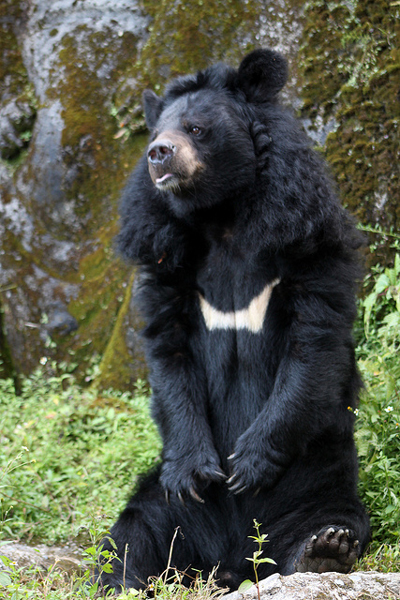
But to conclude that the Yeti isn’t “real” may perpetuate a misunderstanding that began when western and eastern cultures met on the slopes of the Himalayas.
We may think of the Yeti as something of a cryptozoological hoax on par with the Loch Ness Monster.
But something about the Yeti, long present in the lore of local cultures, may have been lost in translation.
It may be that these Western strangers far from home may have simply suffered a failure of imagination and did not fully grasp the cultural context of the Yeti myth.
The major religions of the Himalayan region are polytheistic and inclusive, absorbing older folk beliefs and deities as time goes on. This yields a complex spiritual world full of magical beings and places that are in constant interaction with the landscape and affairs of people.
This perspective encompasses old gods and new gods, mountain spirits and river demons.
The purview of a deity may range from being, say, a goddess of destruction, to such minor responsibilities as guarding over a river crossing or one’s home.

Indeed, according to the traditions of Lepcha people who are indigenous to the Himalayan region, the Yeti is an ape-like glacier spirit that holds influence over the success of hunting trips.
Often, tales of the Yeti hint at something that is beyond reality. It isn’t easy to parse the first-hand reports of the Yeti – it is reported as being seen in the flesh, yet it is also given mythical powers.
For example, according to an account by Ang Tsering Sherpa who recalled a time when his father saw a Yeti, “If the Yeti had seen my father first, my father wouldn’t have been able to walk. The Yeti can make people so they can’t walk. Then he eats them.”
The real and unreal intermingle in a world full of helpful and vengeful spirits.
Among these, the Yeti was plucked from obscurity and cultural context to be scrutinized as a creature that literally walks the earth.
In retrospect, perhaps one of the most remarkable aspects of the Yeti legend is that Western science took on its potential existence as a hypothesis to test.
Is the Yeti real?
I imagine that with a certain world view, one could easily accept both answers to this question.
New Findings and Insights
Fortunately, the latest peer-reviewed study of Yetis did not merely debunk the beast. It left us with fascinating new findings about the genetics of bears and an important conservation message.
This is that the Himalayan brown bear isn’t just another bear. It is a unique creature of an ancient lineage that is in critical need of scientific and conservation attention.
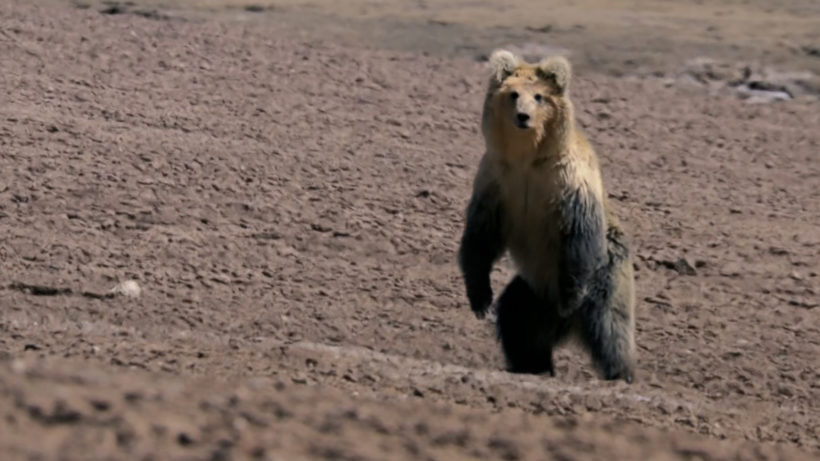
Let’s hope the Himalayan brown bear gains much from its association with the Yeti.
In the end, the Yeti may be now what it has always been: a part of the mythology and folklore of its home.
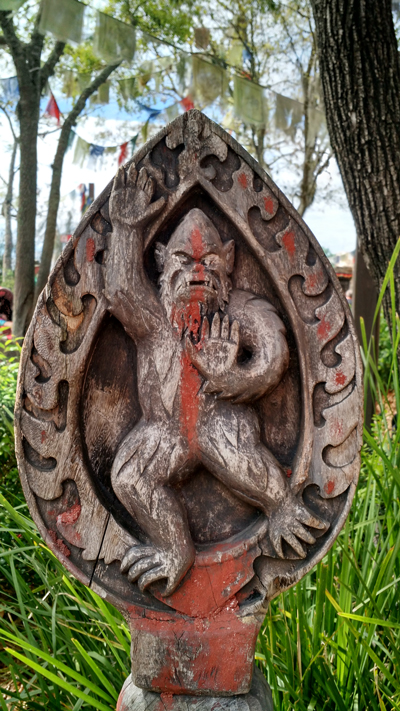
When thinking of the Yeti, I am reminded of Neil Gaiman’s novel American Gods , in which deities from all the world’s religions vie for bandwidth in the human consciousness. The triumphant ones are those who hold the attention of humanity.
The Yeti is an example of a minor deity from a place remote to the Western world that has indeed captured our attention.
This “glacier spirit, god of hunting and lord of all forest beasts” is now renowned across the globe.
The Himalayas are a captivating place, thanks to both its culture and ecology. So, let’s hold on to both myth and reality: long live the Yeti, and long live the Himalayan brown bear.
Join the Discussion
Join the discussion cancel reply.
Please note that all comments are moderated and may take some time to appear.
I think some people are missing the point. It is ‘real’ in the sense that it’s based on a real creature – the Himalayan Brown Bear. But it’s more of a ‘bear-spirit’ than the real animal. As the article says, it’s a cultural thing not a zoological one. As to the Lepcha’s ape-like creature I wonder if that could be a race-memory of orang-utans, which did once inhabit the foothills of the Himalaya; or the langur monkey.
I agree with elizabeth
the yeti is maybe real. im not sure but this looks legit.
I think ‘yeti’ is not real because if he was real he would be I think found by now. I think this is why he isn’t real. When saw some pic he they looked fake and when we find some sighs then we can also find the fingerprints.
I was hiking in the Himalayas with four other people, two Americans, one Nepali, and one Brit, when I spotted something moving in the far distance across the divide on the side of another mountain, maybe two miles away from us. I asked one of the two Americans, who were on a photo safari, if I could use his high-powered lens to get better look. He allowed me to do so. When I looked I saw not one but 9 brown ape-like creatures walking in a scattered line along a path which traversed the side of a mountain. In the lead were three larger ones with two of the smallest ones in close proximity moving along together. About 30 feet behind them were three medium sized ones which were clumped together and sort of tumbling with each other as they moved along. Last, about 20 feet behind the juveniles, was the biggest one. He was also on all fours moving along the path. I described what I saw to the group. Each one took a look. Each of us saw them. Then I asked the owner of lens to take a shot. He told me he would not take a photo because it wasn’t clear. So I asked him I could watch some more.
He handed me the camera with the lens. I watched for another minute or so, and thought of taking a photo without his permission, but was worried to anger the photographer, when, while I was watching, the Nepali threw a rock which landed in the gravel below us. As I was watching the largest one stood up and searched for a second then looked directly at me. Then all of them raced up the trail and disappeared over the edge of the mountain in a matter of seconds.
The largest one’s face was unmistakably ape-like, rounded with flat features. His chest was broad with reddish hair tinged with gold. The group covered in seconds what would take a human maybe 2-3 hours or longer to climb as there was about a 45 degree angle for the side of that mountain. I took the lens from my eyes and looked at the Nepali who smirked at me when I asked him. “Why’d you do that?” He just shrugged his shoulders and laughed.
They definitely exist. But they are so fast and their senses so specified and superior that they have been able to elude us. And I am glad they have been able to do so as we are the most dangerous and cruelest of species on this planet.
Elizabeth, couldn’t agree more!!! Conserving any animal population is to keep Homo sapiens from discovering their populations!
Great piece Joe! Reminded me of a favorite paper: Lozier, J.D., Aniello, P. and Hickerson, M.J., 2009. Predicting the distribution of Sasquatch in western North America: anything goes with ecological niche modelling. Journal of Biogeography, 36(9), pp.1623-1627. https://goo.gl/Md5efF
“Nice”.
What an interesting article, with terrific photos to match. Thanks very much!
Continue Exploring

May 9, 2022
Story type: TNC Science Brief

The Yeti: Asia's Abominable Snowman

The Yeti, once better known as the Abominable Snowman, is a mysterious bipedal creature said to live in the mountains of Asia. It sometimes leaves tracks in snow, but is also said to dwell below the Himalayan snow line. Despite dozens of expeditions into the remote mountain regions of Russia, China and Nepal, the existence of the Yeti remains unproven.
The Yeti is said to be muscular, covered with dark grayish or reddish-brown hair, and weigh between 200 and 400 lbs. (91 to 181 kilograms) It is relatively short compared to North America's Bigfoot, averaging about 6 feet (1.8 meters) in height. Though this is the most common form, reported Yetis have come in a variety of shapes.
History of the Yeti
The Yeti is a character in ancient legends and folklore of the Himalaya people. In most of the tales, the Yeti is a figure of danger, author Shiva Dhakal told the BBC . The moral of the stories is often a warning to avoid dangerous wild animals and to stay close and safe within the community.
Alexander the Great demanded to see a Yeti when he conquered the Indus Valley in 326 B.C. But, according to National Geographic, local people told him they were unable to present one because the creatures could not survive at that low an altitude.
In modern times, when Westerners started traveling to the Himalayas, the myth became more sensational, according to the BBC. In 1921, a journalist named Henry Newman interviewed a group of British explorers who had just returned from a Mount Everest expedition. The explorers told the journalist they had discovered some very large footprints on the mountain to which their guides had attributed to "metoh-kangmi," essentially meaning "man-bear snow-man." Newman got the "snowman" part right but mistranslated "metoh" as "filthy." Then he seemed to think "abominable" sounded even better and used this more menacing name in the paper. Thus a legend was born.
In her book " Still Living? Yeti, Sasquatch, and the Neanderthal Enigma " (1983, Thames and Hudson), researcher Myra Shackley offers the following description, reported by two hikers in 1942 who saw "two black specks moving across the snow about a quarter mile below them." Despite this significant distance, they offered the following very detailed description: "The height was not much less than eight feet ... the heads were described as 'squarish' and the ears must lie close to the skull because there was no projection from the silhouette against the snow. The shoulders sloped sharply down to a powerful chest ... covered by reddish brown hair which formed a close body fur mixed with long straight hairs hanging downward." Another person saw a creature "about the size and build of a small man, the head covered with long hair but the face and chest not very hairy at all. Reddish-brown in color and bipedal, it was busy grubbing up roots and occasionally emitted a loud high-pitched cry."
It's not clear if these sightings were real, hoaxes or misidentifications, though legendary mountaineer Reinhold Messner, who spent months in Nepal and Tibet, concluded that large bears and their tracks had often been mistaken for Yeti. He describes his own encounter with a large, unidentifiable creature in his book " My Quest for the Yeti: Confronting the Himalayas' Deepest Mystery " (St. Martin's, 2001).
In March 1986, Anthony Wooldridge , a hiker in the Himalayas, saw what he thought was a Yeti standing in the snow near a ridge about 500 feet (152 meters) away. It didn't move or make noise, but Wooldridge saw odd tracks in the snow that seemed to lead toward the figure. He took two photographs of the creature, which were later analyzed and proven genuine.
Many in the Bigfoot community seized upon the photos as clear evidence of a Yeti, including John Napier , an anatomist and anthropologist who had served as the Smithsonian Institution's director of primate biology. Many considered it unlikely Wooldridge could have made a mistake because of his extensive hiking experience in the region. The following year, researchers returned to where Wooldridge had taken the photos and discovered that he had simply seen a dark rock outcropping that looked vertical from his position. It was all a mistake — much to the embarrassment of some Yeti believers.
Yeti evidence?
Most of the evidence for the Yeti comes from sightings and reports. Like Bigfoot and the Loch Ness monster , there is a distinct lack of hard proof for the Yeti's existence, though a few pieces of evidence have emerged over the years.
In 1960, Sir Edmund Hillary, the first man to scale Mt. Everest , searched for evidence of the Yeti. He found what was claimed to be a scalp from the beast, though scientists later determined that the helmet-shaped hide was in fact made from a serow, a Himalayan animal similar to a goat.
In 2007, American TV show host Josh Gates claimed he found three mysterious footprints in snow near a stream in the Himalayas. Locals were skeptical, suggesting that Gates — who had only been in the area for about a week — simply misinterpreted a bear track. Nothing more was learned about what made the print, and the track can now be found not in a natural history museum but instead in a small display at Walt Disney World.
In 2010, hunters in China caught a strange animal that they claimed was a Yeti. This mysterious, hairless, four-legged animal was initially described as having features resembling a bear, but was finally identified as a civet , a small cat-like animal that had lost its hair from disease.
A finger once revered in a monastery in Nepal and long claimed to be from a Yeti was examined by researchers at the Edinburgh Zoo in 2011. The finger generated controversy among Bigfoot and Yeti believers for decades, until DNA analysis proved that the finger was human, perhaps from a monk's corpse. [See also: Bigfoot & Yeti DNA Study Gets Serious ]
Russian search for Yeti
The Russian government took an interest in the Yeti in 2011, and organized a conference of Bigfoot experts in western Siberia. Bigfoot researcher and biologist John Bindernagel claimed that he saw evidence that the Yeti not only exist but also build nests and shelters out of twisted tree branches. That group made headlines around the world when they issued a statement that they had "indisputable proof" of the Yeti, and were 95 percent sure it existed based on some grey hairs found in a clump moss in a cave.
Bindernagel may have been impressed, but another scientist who participated in the same expedition concluded that the "indisputable" evidence was hoaxed. Jeff Meldrum, a professor of anatomy and anthropologist at Idaho State University who endorses the existence of Bigfoot, said that he suspected the twisted tree branches had been faked. Not only was there obvious evidence of tool-made cuts in the supposedly "Yeti-twisted" branches, but also the trees were conveniently located just off a well-traveled trail and hardly in a remote area.
Meldrum concluded that the whole Russian expedition was more of a publicity stunt than a serious scientific endeavor, likely designed to increase tourism in the impoverished coal-mining region. Despite quasi-official claims of "indisputable proof" of the Yeti, nothing more has come of the story.
DNA samples
In 2013, Oxford geneticist Bryan Sykes put out a call to all Yeti believers and institutions around the world claiming to have a piece of Yeti hair, teeth or tissue taken from a sighting. He received 57 samples, 36 of which were chosen for DNA testing, according to University College London (UCL) . These samples were then compared with the genomes of other animals stored on a database of all published DNA sequences.
Most of the samples turned out to be from well-known animals, such as cows, horses and bears. However, Sykes found that two of the samples (one from Bhutan and the other from India) were a 100 percent match for the jawbone of a Pleistocene polar bear that lived sometime between 40,000 and 120,000 years ago — a period of time when the polar bear and closely related brown bear were separating as species, according to BBC . Sykes thought the sample was probably a hybrid of a polar bear and a brown bear.
However, two other scientists, Ceiridwen Edwards and Ross Barnett, conducted a re-analysis of the same data. They said that the sample actually belonged to a Himalayan bear, a rare subspecies of the brown bear. Their study results were published in the Royal Society journal, Proceedings of the Royal Society B.
Another team of researchers, Ronald H. Pine and Eliécer E. Gutiérrez , also analyzed the DNA and also concluded that "there is no reason to believe that Sykes et al.'s two samples came from anything but ordinary brown bears."
And in 2017, yet another team of researchers analyzed nine "Yeti" specimens , including bone, tooth, skin, hair and fecal samples collected from monasteries, caves and other sites in the Himalayas and the Tibetan Plateau. They also collected samples from bears in the region and from animals elsewhere in the world.
Of the nine yeti samples, eight were from Asian black bears, Himalayan brown bears or Tibetan brown bears. The ninth was from a dog.
True believers undeterred
The lack of hard evidence despite decades of searches doesn't deter true believers; the fact that these mysterious creatures haven't been found is not taken as evidence that they don't exist, but instead how rare, reclusive, and elusive they are. Like Bigfoot, a single body would prove that the Yeti exist, though no amount of evidence can prove they don't exist. For that reason alone, these animals — real or not — will likely always be with us.
Additional reporting by Traci Pedersen, Live Science contributor.
Additional resources
- BBC: Is the Himalayan Yeti a real animal?
- Bigfoot Encounters: An encounter in Northern India, by Anthony B. Wooldridge
- Committee for Skeptical Inquiry: No Reason to Believe That Sykes’s Yeti-Bear Cryptid Exists
Ever seen Bigfoot's eyeshine in your headlights at night? Heard a splash and sworn you saw Nessie's tail disappearing below the lake surface? Cryptic creatures of myth and legend are known the world over.
Bigfoot, Nessie & the Kraken: Cryptozoology Quiz
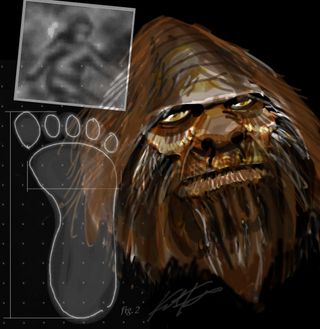
Sign up for the Live Science daily newsletter now
Get the world’s most fascinating discoveries delivered straight to your inbox.
'Yeti hair' found in Himalayas is actually from a horse, BBC series reveals
Haunting 'mermaid' mummy from Japan is a gruesome monkey-fish hybrid with 'dragon claws,' new scans reveal
China rover returns historic samples from far side of the moon — and they may contain secrets to Earth's deep past
Most Popular
- 2 Newly deciphered papyrus describes 'miracle' performed by 5-year-old Jesus
- 3 Earth's rotating inner core is starting to slow down — and it could alter the length of our days
- 4 Long-lost Assyrian military camp devastated by 'the angel of the Lord' finally found, scientist claims
- 5 32 of the most dangerous animals on Earth
- 2 Astronauts stranded in space due to multiple issues with Boeing's Starliner — and the window for a return flight is closing
- 3 James Webb telescope spots a dozen newborn stars spewing gas in the same direction — and nobody is sure why
- 4 Human ancestor 'Lucy' was hairless, new research suggests. Here's why that matters.
- 5 'The early universe is nothing like we expected': James Webb telescope reveals 'new understanding' of how galaxies formed at cosmic dawn
New Research
Most “Yeti” Evidence Is Actually From Brown Bears
The results dispel the idea of these mythical beasts while providing clues to the ancestry of the elusive Himalayan and Tibetan bears
Jason Daley
Correspondent
/https://tf-cmsv2-smithsonianmag-media.s3.amazonaws.com/filer/8b/39/8b398670-5883-43b5-8606-dc15f3fcfd32/yeti_bone.jpg)
The yeti, aka the Abominable Snowman, has been part of Himalayan lore for centuries —but has also long intrigued people around the world. Even Alexander the Great demanded to see a yeti when he conquered the Indus Valley in 326 B.C. (he was told they only lurked at higher altitudes). Modern explorers have also tried to track the elusive beast, collecting "evidence" in the form of scat, hair, bones and more from across the Himalayan mountain range.
Now, reports Sarah Zhang at The Atlantic , some of the best of this evidence has been put to the test. And it turns out, most yeti samples actually come from brown bears.
The latest tale began with the filming of a special production on the yeti for the cable television channel Animal Planet. As Zhang reports, the production company, Icon Films, contacted biologist Charlotte Lindqvist in the fall of 2013 with a request: they needed DNA testing of yeti evidence.
Lindqvist is a professor at University of Buffalo who specializes in species genetics and agreed to the unusual project. So the team began sending her samples. According to Sid Perkins at Science , these included a tooth and hair collected from Tibet in the 1930s , scat that was in the collections of a museum operated by the Italian mountaineer and Yeti-chaser Reinhold Messner , as well as a leg bone and other hair samples—all of these were claimed to come from yetis.
In all, Lindqvist and her colleagues examined the mitochondrial DNA of nine supposed yeti samples. They also studied 15 additional samples obtained from Lindqvist's network of contacts that were from Himalayan and Tibetan brown bears and Asian black bears for comparison. They detailed their results in a new study published in the journal Proceedings of the Royal Society B.
Of the nine purported yeti samples, seven came from Himalayan or Tibetan brown bears, one came from a black bear, and one came from a dog. While the producers and "true believers" are likely dismayed by the finding, Lindqvist was ecstatic.
Though it would've been a coup to find some yeti DNA, Lindqvist was after the genetic material of the brown bear sub species—creatures that are still elusive but more rooted in reality.
“When I had to reveal to them that okay, these are bears, I was excited about that because it was my initial motive to get into this,” Lindqvist tells Zhang. “They obviously were a little disappointed.”
As Perkins reports, the team did indeed find some interesting data from the samples. They were able to create the first full mitochondrial genomes for the Himalayan brown bear ( Ursus arctos isabellinus ) and the Himalayan black bear ( Ursus thibetanus laniger ). As Zhang reports, the research also showed the Himalayan brown bear and the Tibetan brown bear are more genetically distinct from one another than previously thought.
Brown bears roam across the northern hemisphere, and many subspecies, like the American grizzly and Alaskan Kodiak bear, are spread across the world, reports Ben Guarino at The Washington Post . The research indicates that the Himalayan subspecies was likely the first to diverge from the ancestral brown bear about 650,000 years ago.
“Further genetic research on these rare and elusive animals may help illuminate the environmental history of the region, as well as bear evolutionary history worldwide—and additional 'Yeti' samples could contribute to this work,” Lindqvist says in a press release . As Zhang reports, the research also puts the kibosh on another theory that emerged from a previous Icon Films investigation of yetis. For that film, the company collaborated with Oxford geneticist Bryan Sykes who examined yeti samples, concluding that one sample matched the DNA from an ancient polar bear. That led to some speculation that the yeti might be a hybrid of a brown bear and polar bear. However, re-examination found that the sample came from a Himalyan brown bear , and Lindqvist believes she sequenced hair from the same sample, confirming that the creature was nothing out of the ordinary.
Even if science doesn't support the yeti's existence, don’t worry: We’ll always have Sasquatch. This mythical beast continues to persist in popular culture amid a sea of hoaxes, blurry photos and breathless cable shows .
Get the latest stories in your inbox every weekday.
Jason Daley | | READ MORE
Jason Daley is a Madison, Wisconsin-based writer specializing in natural history, science, travel, and the environment. His work has appeared in Discover , Popular Science , Outside , Men’s Journal , and other magazines.

Yeti Legends Are Based on These Real Animals, DNA Shows
The best look yet at supposed Yeti samples also offers valuable insight into the genetic histories of rare Himalayan bears.
Among the snowy peaks of Nepal and Tibet, stories tell of a mysterious ape-like creature called the Yeti. Purported to be a towering human-like figure covered in shaggy fur, the Yeti continues to excite dedicated believers still hoping for evidence that the mythical beast is real. (Read about a man who searched for the Yeti for 60 years .)
Now, DNA analysis of multiple supposed Yeti samples—including hair, teeth, fur, and feces—shows that the stories are based on real animals roaming the high mountains. The results, published this week in the Proceedings of the Royal Society B , are the best evidence yet that the Yeti legend is rooted in Himalayan black and brown bears .
Study leader Charlotte Lindqvist of the University at Buffalo in New York and her team examined nine Himalayan Yeti samples from museums and private collections. One was a tooth from a stuffed specimen at the Reinhold Messner Mountain Museum in Italy. Another was a piece of skin from a supposed Yeti hand that became a religious relic in a monastery.
Their detailed DNA work shows that the tooth came from a domestic dog , while the rest of the samples clearly came from Himalayan and Tibetan subspecies of brown bear and an Asian black bear. The results offer a window into the origins of Yeti stories, which have been told for centuries.
“Analysing Yeti samples and showing that the majority are from bears provides a connection between the myths of a rare wildman and a real creature which can occasionally be scary,” says Ross Barnett, an evolutionary biologist and expert on ancient DNA at Durham University in the U.K.
The work also allowed the team to create a new family tree of vulnerable subspecies of Asian bears, which may prove useful in efforts to protect the animals.
Enduring Myth
Lindqvist, who is currently a visiting associate professor at Nanyang Technological University in Singapore, became interested in Yeti lore due to a scientific misunderstanding.
She was involved in the discovery and analysis of a 120,000-year-old polar bear jawbone found in Arctic Norway in 2004. Almost a decade later, she saw her work cited in a University of Oxford study linking that polar bear jaw to Yeti remains.
According to the now controversial paper published in 2014 , two Yeti fur samples from Bhutan and northern India matched up to the ancient polar bear DNA. The team behind it argued that a polar bear-brown bear hybrid could still be alive somewhere in the snowy mountaintops. Lindqvist, however, was not convinced and decided to double check the findings for herself.
“I got a little bit suspicious about how there could be polar bears in the Himalayas,” she says. She also had concerns about the study methods, because the team looked at relatively short and limited sections of DNA.
Her team gathered a total of 24 samples from Asian bears and purported Yetis. While the team could not get their hands on the exact fur samples analysed four years ago, Lindqvist suspects that one of her samples came from the Indian animal. They completed a more detailed analysis of longer DNA sequences, which she says is more likely to yield robust results.
“This study clearly confirms that the Yeti samples tested are actually from bears living in the Himalayas and the Tibetan region,” says Bill Laurence , a conservation biologist at James Cook University in Queensland, Australia, who was not involved in the new paper.
For Lindqvist, collecting and studying so-called Yeti remains was “a nice segue into possibly getting samples and getting better insight into the evolutionary history of bears in the region.”
For instance, her team’s new family tree suggests that while Tibetan brown bears are closely related to brown bears from Europe and North America, critically endangered Himalayan brown bears are part of an older lineage that may have split off from all other bears 650,000 years ago during a period of ice age glaciation.
Barnett says that the new study is doubly important because, prior to this, there had been very little genetic work done on the vulnerable or endangered bears of the region. He hopes the paper will increase understanding of Himalayan brown bears and aid in their conservation.
But even with the robust nature of the new genetic findings, Barnett adds, the legend of the Yeti will likely live on.
“You can’t debunk a myth with anything as mundane as facts,” he says. “As long as the stories are told and retold—and bears are glimpsed in other than ideal conditions or leave melting footprints in the snow—there will be stories of Yetis.”
Follow John Pickrell on Twitter .
Related Topics
You may also like.

Dog DNA tests are on the rise—but are they reliable?

Wild animals are adapting to city life in surprisingly savvy ways

Animal-friendly laws are gaining traction across the U.S.

Surrounded by sounds—of music, science, animals, and more

How the DNA method that caught the Golden State Killer can help catch elephant poachers
- Environment
History & Culture
- History & Culture
- History Magazine
- Race in America
- Mind, Body, Wonder
- Destination Guide
- Terms of Use
- Privacy Policy
- Your US State Privacy Rights
- Children's Online Privacy Policy
- Interest-Based Ads
- About Nielsen Measurement
- Do Not Sell or Share My Personal Information
- Nat Geo Home
- Attend a Live Event
- Book a Trip
- Inspire Your Kids
- Shop Nat Geo
- Visit the D.C. Museum
- Learn About Our Impact
- Support Our Mission
- Advertise With Us
- Customer Service
- Renew Subscription
- Manage Your Subscription
- Work at Nat Geo
- Sign Up for Our Newsletters
- Contribute to Protect the Planet
Copyright © 1996-2015 National Geographic Society Copyright © 2015-2024 National Geographic Partners, LLC. All rights reserved
Latest DNA Analysis Shows The Yeti Are Actually Just a Bunch of Bears

The Yeti of the mountains of Asia, hairy like a white ape, yet bipedal and standing taller than a man, is numbered among the world's most beloved cryptids. Yet, for all the eyewitness accounts, physical evidence of the beast is proving tricky to pin down.
Nary a fossil, nor a corpse. But, like its American cousin Bigfoot, pieces of hair and bone, of tooth and skin, have made their way into private collections. Now, DNA analysis on nine of those has proven there's still no physical evidence - all those samples came from regular old animals.
The nine samples, collected from the Himalayas and the Tibetan Plateau, included hair, skin, tooth, bone, and faecal matter. All but one of them turned out to be from bears - Asian black bears, Himalayan brown bears, or Tibetan brown bears.
The remaining sample, a tooth from the Reinhold Messner Mountain Museum, was from a domestic dog.
"Our findings strongly suggest that the biological underpinnings of the Yeti legend can be found in local bears, and our study demonstrates that genetics should be able to unravel other, similar mysteries," said biologist Charlotte Lindqvist from the University at Buffalo College of Arts and Sciences.
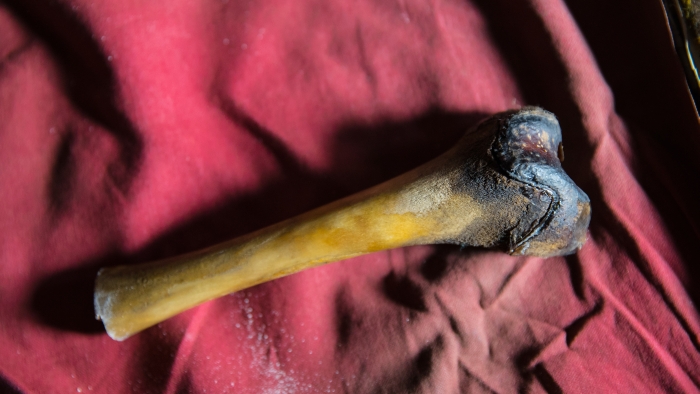
Her team isn't the first to conduct DNA analysis on what was believed to be samples of cryptid hair.
In 2014, a team of researchers at the University of Oxford in the UK and the Museum of Zoology in Lausanne, Switzerland, led by Oxford geneticist Bryan Sykes, published a paper describing how they had put 37 hair samples from around the world to the test.
It was the first ever genetic survey of "anomalous primate" samples, and it had, well, a similar result. Every single one of the samples that returned a result matched a known species - from polar bear to sheep to human.
That research, however, was based on a simpler genetic test than the research her team conducted, Lindqvist said. Sykes and his team used mitochondrial RNA sequencing.
Lindqvist and her team applied PCR amplification, mitochondrial sequencing, mitochondrial genome assembly, and phylogenic analysis.
Sykes - not without his detractors among the cryptid enthusiast community - was nevertheless careful to note that a lack of evidence was not proof for the non-existence of anomalous primates.
"Rather than persisting in the view that they have been 'rejected by science', advocates in the cryptozoology community have more work to do in order to produce convincing evidence for anomalous primates and now have the means to do so," Sykes' team wrote in their paper .
Lindqvist draws a different conclusion - that the yeti-cum-bear samples provide evidence that the cryptid myth may have evolved from encounters with real animals.
Just as the okapi, discovered in 1901, was reportedly fabled as an " African unicorn ," for instance, or remains of Australia's megafauna could have given rise to Aboriginal myths such as the Giant Devil Dingo .
"Clearly," Lindqvist said , "a big part of the Yeti legend has to do with bears."
But the research has other applications outside of cryptid research - the DNA sequenced, when compared to living or modern animals, can provide some insight into the evolution of the bears, many of which are vulnerable or endangered.
The team sequenced the mitochondrial DNA of 23 Asian bears (including the Yeti samples) and compared it with other bears around the world.
They found that Tibetan brown bears are closely related to American bears, but Himalayan bears belong to a different evolutionary lineage that split around 650,000 years ago, during a major ice age .
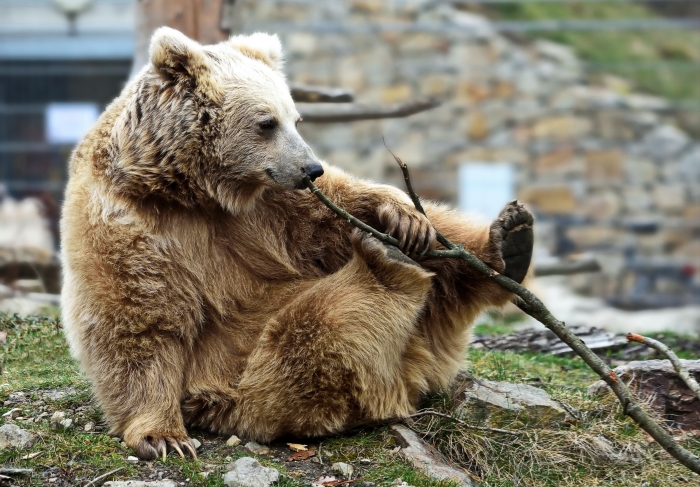
This could have occurred when the ice significantly changed the landscape, separating groups of bears that then followed separate evolutionary paths.
"Further genetic research on these rare and elusive animals may help illuminate the environmental history of the region, as well as bear evolutionary history worldwide - and additional 'Yeti' samples could contribute to this work," Lindqvist said .
The Yeti samples were provided to Lindqvist by production company Icon Films for an Animal Planet special called " Yeti or Not ."
The research has been published in the journal Proceedings of the Royal Society B .
When Edmund Hillary Went in Search of the Yeti
In 1961, the pursuit of the abominable snowman was still taken seriously..

The Yeti Scalp of Khumjung
September 9, 1960: Kathmandu hums with the discordant music of drums and flutes. People disguised as dancing deities have traveled from all over Nepal to clap and sing their way through the streets as part of a festival honoring the Hindu god Indra, revered as the king of heaven. Amid the colorful melee winds 40-year-old Brit Desmond Doig, mountaineer, journalist, and photographer for National Geographic and Life magazine.
In the midst of the chaos, Doig spots a shaggy-haired wool and bamboo figure halfway between a man and an ape adorning the wall of a temple. “To the Nepali they are ‘Ban Manchhuru’,” Doig writes in the 1962 book High in the Thin Cold Air . “To our Sherpas and us… the figures represent the Abominable Snowman.”
Doig hadn’t traveled all the way to the Nepali capital to honor Indra. As part of the 1960-61 Silver Hut expedition led by Edmund Hillary, then the world’s most famous mountaineer, Doig had come in search of a creature that, like a god, occupied the rarified air between myth and reality. He had come in search of Nepal’s abominable snowman, also known as the yeti.
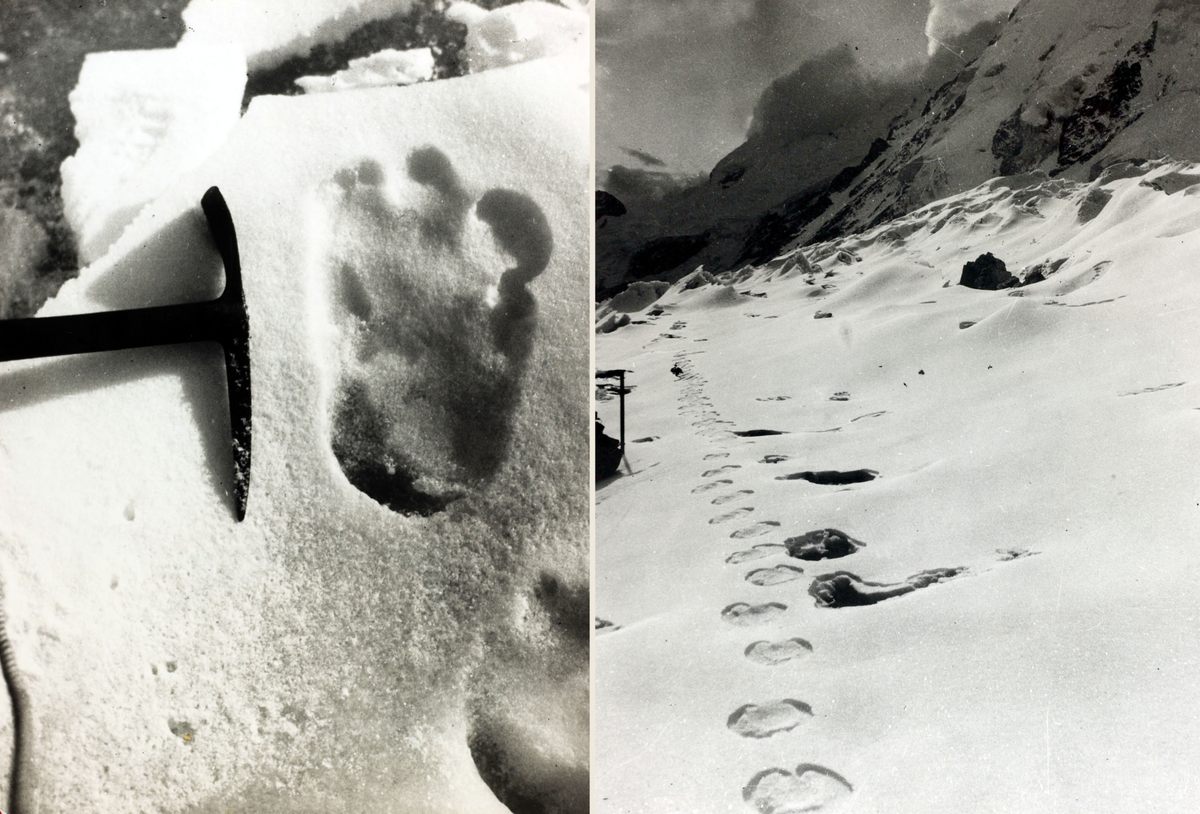
In the 1950s and early ‘60s the Western world was in the grip of yeti mania. In 1951, the legendary mountaineer Eric Shipton had photographed what he believed to be yeti tracks in northeastern Nepal. The following year, Hillary himself encountered a scrap of skin covered in blue-black fur while climbing in the Cho Oyu region of the Himalayas and was told by his Sherpa porters that the hair belonged to a yeti.
Following two bloody World Wars and indeed, Hillary’s earlier exploits, the vast majority of the globe was now known to Western audiences. The sections of the map reading “Here be monsters” were growing fewer and fewer, yet the appetite for undiscovered lands and unseen monsters had never been stronger.
Belief in the yeti can be traced to pre-Buddhist religions, but widespread interest came about as Western mountaineers first began to climb the Himalayas and brought the local legends home with them. When the race to conquer Everest heated up in the 1950s, so too did the number of alleged yeti sightings. Western audiences were hooked, eager for news of this evolutionary hangover halfway between man and beast. Perhaps it was comforting to think that there were beings beyond comprehension surviving at the ends of the wilderness and that, crucially, there were still enough wild places left to hold them.
So popular was the yeti legend that British newspaper the Daily Mail launched its own expedition to Nepal in 1953. The trip cost the equivalent of $1.35 million in today’s money but ultimately failed to find any proof of the yeti. All of which simply meant that in 1960 yetis were still out there to be found.
“The yeti wasn’t considered mythical in the early ’60s,” explains Graham Hoyland, mountaineer and author of Yeti: An Abominable History. Hoyland points to the Nepali government’s official 1947 memo outlining the etiquette of a yeti hunt, republished by the American embassy in Kathmandu in 1959 and issued to Hillary’s party as “ Regulations Covering Mountain Climbing Expeditions in Nepal Relating to Yeti.” It stipulates that the search for yetis required a permit and that a yeti could not be killed except in self-defense.
That Edmund Hillary might set off in search of the abominable snowman, then, was not the wild, conspiracy-theory-baiting story it would appear to be today. That he and Doig might actually encounter a wild yeti was considered a very real possibility.

It was in this spirit that the Hillary expedition set out into the Rolwaling Valley on the morning of September 10, 1960. The valley selected because Sherpas had reported yeti sightings in the area and because of its proximity to Mount Makalu, the world’s fifth highest mountain; the nine-month expedition would go on to study the effects of long-term exposure to high altitudes on human fitness after the search for the yeti was concluded.
Among those traveling on the dual-purpose expedition were Peter Mulgrew and Wally Romanes, who had accompanied Hillary on his 1955-58 expedition to Antarctica; American space physiologist Dr Tom Nevison and glaciologist Barry Bishop, both well suited to measuring the effects of long-term altitude exposure; and Marlin Perkins, director of the Lincoln Park Zoo, and Dr Larry Swan a self-described “Himalayanist,” whose expertise seemed ideal for a yeti hunt. In other words, this was a serious, well-funded and professional expedition, one backed by World Book Encyclopedia
The group would study local stories, tracks and relics purported to be Yeti body parts in order to establish or disprove the legend. “Our ambition, of course, was to capture a live Snowman,” writes Doig. Hillary seemed more skeptical. “I think there is precious little in civilisation to appeal to a Yeti,” Doig reports him as saying.

According to Sherpa legend, the yeti is a genus of high-altitude-dwelling, ape-like creatures with three distinct species: the dzu-teh is a six-to-eight-foot bearlike creature covered in either blond, red, black, or gray hair. Despite being largely vegetarian, dzu-tehs have been known to deploy its long claws in the hunting of cattle. The mih-teh is a two-legged creature the size of a small man and is covered in black or red hair with a long mane hanging over its eyes. Finally, Doig writes, the thelma is said to be a “sad-faced, dwarf-sized beast found in dense forests below 10,000 feet.”
The sheer amount of firepower taken along by the explorers demonstrates a significant sense of caution toward the animal that might or might not exist. Their armory included Cap-Chur guns capable of firing tranquilizer darts as well as rifles, shotguns, tear gas pistols, and “light arms.” “None of us particularly wanted to shoot one,” wrote Doig. “But we carried conventional rifles in self-defense as most accounts of the Yeti describe it as being savage in the extreme.”
The climbers and scientists were never called upon to defend themselves. The closest they came to encountering a yeti was the strange footprints they found in the snow. Located 20 to 30 inches apart, Doig writes, the prints seemed to be made “by naked human feet—size elevens or even fifteen, broad across the instep, fallen arches, and a big toe that protruded inward.”
Hillary dismissed the prints as having been made by snow leopards or wolves and claimed, “I would like a lot more convincing proof.” Doig, Swan, Perkins, and a few others set to work documenting the tracks with sketch books and measuring tapes, taking photographs, and attempting to make plaster of Paris casts, but it soon became clear that the prints were not made by a mysterious creature, but by the hot sun, which distended the tracks of much smaller, perfectly ordinary animals.
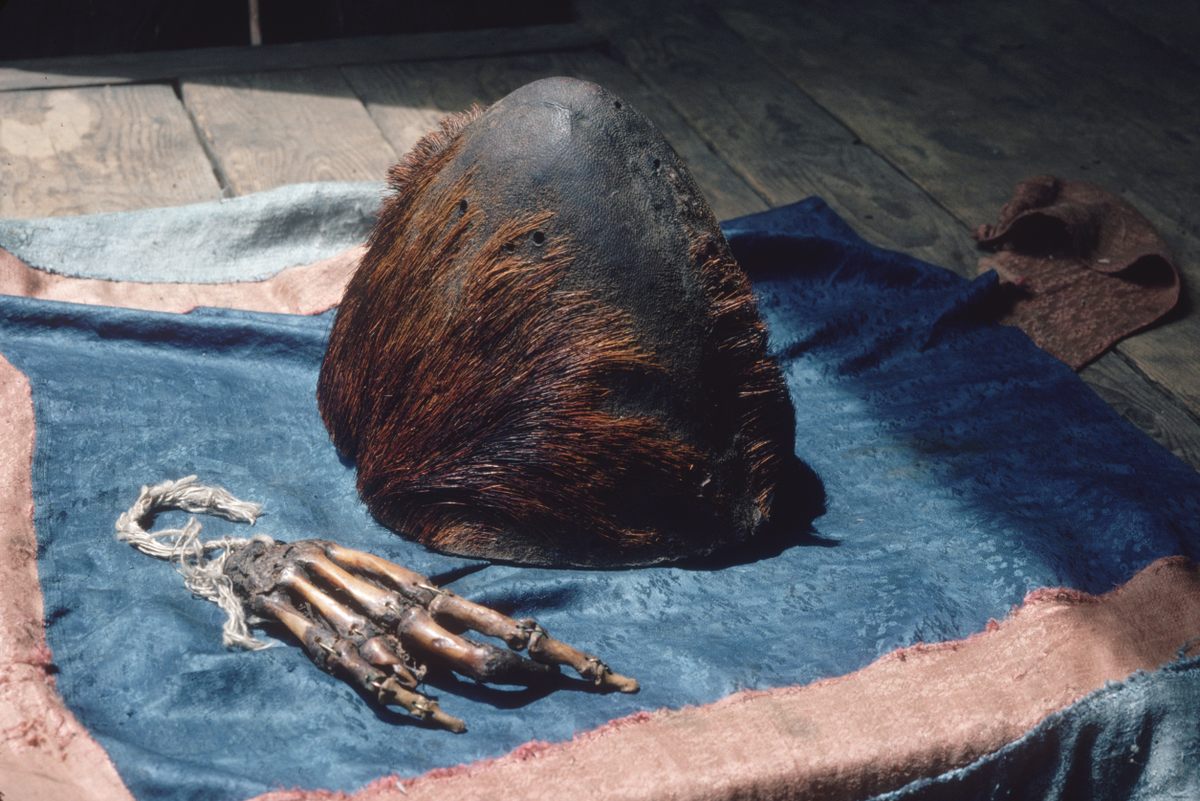
With the Yeti prints discredited, the only remaining “proof” came in the form of scraps of “relics” many locals seemed keen to sell at high prices, such as a “yeti hand” stored at a monastery in Pangboche; an analysis of a photograph revealed it to most likely be a human hand strung together with wire. Likewise, the numerous yeti skins shown to the expedition team—mostly blue-black with a white stripe across the shoulders—were widely agreed to belong to the Tibetan blue bear.
Three Yeti “scalps” held at local monasteries were the hardest pieces of evidence to disprove. After much wrangling, Hillary was given permission to take one scalp abroad for one month to be examined by scientists in Paris, Chicago, and London.
“I have never believed in the existence of the snowman,” Hillary outright claimed in an interview conducted with Stars and Stripes at the start of the scalp’s scientific tour. But he did allow for the possibility he was wrong. “The scalp is hard to explain. It’s a convincing sort of specimen,” he says, likely out of deference to the Sherpa people. “The local people regard it as a yeti scalp and look upon it with respect.”
Eventually, the scientists agreed the scalp was likely a fake, possibly constructed from the skin of a serow, a goat-like creature found in the Himalayas. “Pleasant though we felt it would be to believe in the existence of the Yeti,” Hillary wrote in High in the Thin Cold Air , “when faced with the universal collapse of the main evidence in support of this creature the members of my expedition … could not in all conscience view it as more than a fascinating fairy tale.”
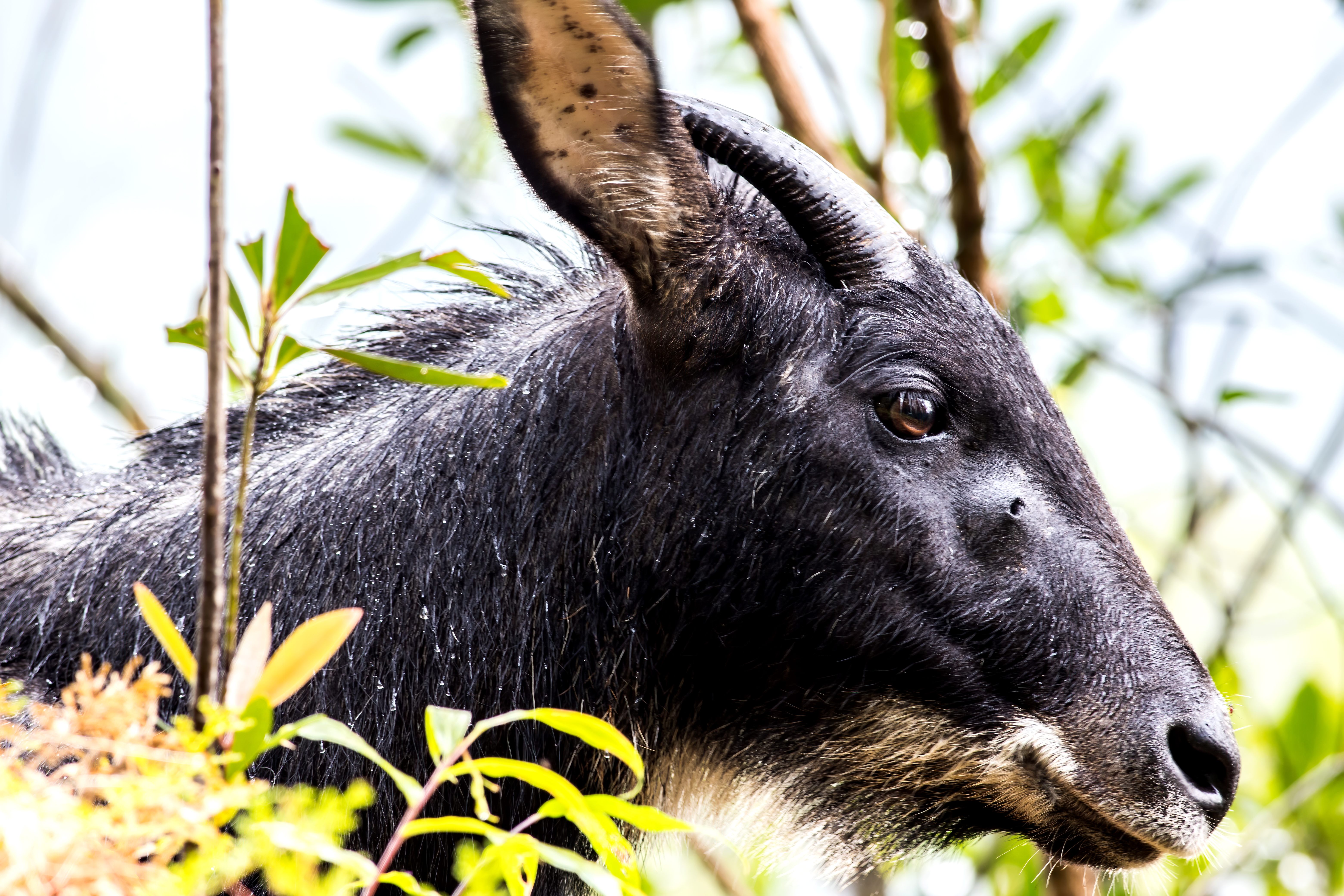
If Hillary had always doubted the existence of the yeti, why set off on a hunt at all? Ed Douglas, author of Tenzing: Hero of Everest and Himalaya: A Human History , suggests that Hillary used the headline-grabbing yeti hunt to get funding for the research portion of the expedition. “The yeti was a useful marketing tool,” writes Douglas. “I doubt Hillary really believed in it except when he was talking to PR people.”
Hoyland, who claims to have encountered a yeti footprint in Bhutan, believes otherwise. “Hillary was a mountaineer, and any mountaineer will jump at the opportunity to go and hunt for a yeti. I did, too.”
Whether Hillary’s Yeti hunt was a public relations stunt or something more, not everyone was satisfied by the expedition’s findings, which came as popular belief in the yeti’s existence began to fade. “I hope we are wrong about the yeti,” Doig wrote in High in the Thin Cold Air . “Whatever one may think of the legend… there certainly is something in the high Himalayas to spark the descriptions of a shaggy red monster walking usually on two feet.”
Podcast: Panorama of the City of New York

Using an ad blocker?
We depend on ad revenue to craft and curate stories about the world’s hidden wonders. Consider supporting our work by becoming a member for as little as $5 a month.
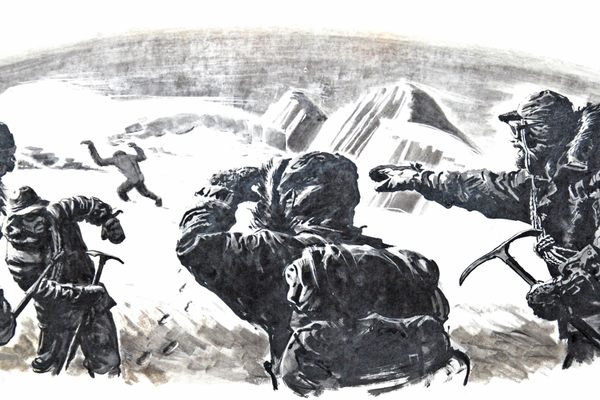
DNA Says 'Yeti' Evidence Comes From Bears, But Will Believers Be Convinced?

Could 'Monsters' Exist in the Modern World?

Podcast: Hårgaberget
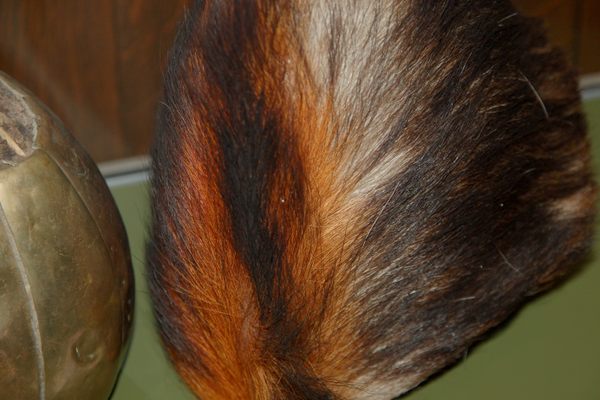
Objects of Intrigue: Yeti Scalp

Here Be Dragons: Secrets of One of the Earliest Terrestrial Globes

Meet Nepal’s Mountain Porters

The Story Behind This Giant Rock in the Middle of a Field | Untold Earth

How the Fictional Town of Sleepy Hollow Became Real

Atlas Obscura Tries: Magnet Fishing

A 30-Acre Garden Inspired by the Principles of Modern Physics

The Flesh-Eating Beetles of Chicago's Field Museum

Inside Ohio's Experimental Archaeology Lab

A Visit to Buffalo's Lava Lab

Where Scientists Play With Fire

A Colossal Squid Is Hiding in New Zealand

This Volcano Won't Stop Erupting | Untold Earth

Follow us on Twitter to get the latest on the world's hidden wonders.
Like us on Facebook to get the latest on the world's hidden wonders.

Pre-Order Atlas Obscura: Wild Life Today!
Add some wonder to your inbox, we'd like you to like us.

Mysteries of the yeti
He authors of a recent proceedings b article on the evolutionary history of brown bears used genetic analyses to show the phylogenetic relationships and evolutionary history of himalayan and tibetan bears, thus shedding light on the possible identity of the yeti..

The exact identity of the yeti, an ape-like creature, important to folklore and mythology in the Tibetan Plateau-Himalaya region is still surrounded by mystery. The authors of a recent Proceedings B article on the evolutionary history of brown bears used genetic analyses to show the phylogenetic relationships and evolutionary history of Himalayan and Tibetan bears, thus shedding light on the possible identity of the yeti. We spoke to lead author, Charlotte Lindqvist about this fascinating research and findings.
Tell us about yourself and your research?
I’m an Associate Professor in the Department of Biological Sciences at the University at Buffalo, currently a Visiting Associate Professor at Nanyang Technological University in Singapore. I am an evolutionary geneticist, broadly interested in understanding the processes and patterns of species diversification, and how it is impacted by hybridisation and responses to environmental perturbations, in both animals and plants. One of my research projects involves polar and brown bear evolutionary history and I am sequencing genomes of both modern and ancient, subfossil bears. I find it fascinating how such large and iconic animals display an excellent example of complex speciation in response to climatic changes. This is something we, today, can address much better than ever with genomic data.
What does your paper tell us?
The findings of our paper are two-fold. First, we conducted a comprehensive genetic survey to explore the identity of animal remains. These included bone, skin, hair and fecal samples that had been collected in the Himalayas and Tibetan Plateau and were thought by locals to have come from yetis. By analysing the DNA from these samples, we were able to directly determine that they belonged to local black and brown bears. Secondly, as our ultimate goal was to infer the evolutionary history of bears in the region, we sequenced mitochondrial DNA, including complete mitochondrial genomes from some of these animal remains, and reconstructed their phylogenetic history. We show that the Himalayan brown bear, which is a subspecies of brown bear, is the first-branching lineage of modern brown bears, while the Tibetan brown bear, another subspecies, diverged much later. The Himalayan black bear also appears to hold an isolated position among Asian black bears.
Did you discover anything surprising?
Because many of the samples we worked with were of unknown identity, it was exciting to discover that these samples were in fact related to local bears. Although it has previously been anecdotally associated with local bears, the exact identity of the yeti is still surrounded by mystery. A previous study , recently published in Proceedings B, and based on only two purported yeti samples and limited genetic data, had speculated that an unclassified, and possibly hybrid, bear species might be present in the region, but this preliminary finding had been questioned. Our results refute that finding and strongly suggest that the biological basis of the yeti legend is local brown and black bears, and not a mythical creature or previously unknown bear species.
We were also surprised to find the Himalayan brown bear placed at the base of the brown bear family tree as sister lineage to all other modern brown bears. Genetic relationships of most of the world’s brown bear populations have been fairly well studied but very limited data existed of the Himalayan brown bear and it was not clear how these endangered and elusive bears from the northwestern Himalayan region were related to other brown bear populations. It was a similar story with the Himalayan black bear. Our results indicate that both of these bear populations diverged early and experienced long isolation from other bear populations, likely in response to major glaciation events in the region.
What implications does your research have on the field?
To my knowledge, this study represents the most rigorous analysis to date of samples suspected to derive from anomalous or mythical ‘hominid’-like creatures, and it demonstrates that genetics will be able to unravel other, similar mysteries. In recent years, the techniques of recovering DNA from historical and ancient samples have vastly improved and our study also helps to demonstrate that biological samples archived in museums or private collections can significantly aid in our understanding of the genetic variation and phylogeographic patterns of rare and widespread species that may otherwise be difficult to get hold of.
I also hope that our study will help increase the attention on bears in this region. Both brown and black bears in the Himalayas are either vulnerable or critically endangered but not much is known about them. Our study helps placing these bear populations in a global perspective, e.g., they appear to hold important clues to the evolutionary history of bears around the world and likely also the climatic history of the geologically dynamic and young Himalayas and Tibetan Plateau. It is clear that increasing knowledge on their population structure and genetic diversity will not only be important for studies of worldwide brown bear populations but also for estimating population sizes and guiding conservation management strategies of bears in the region.
What made you submit to Proceedings B and what was your experience of the process?
An earlier study about the identity of purported yeti samples had been published in Proceedings B and I thought it would be an appropriate place to submit our paper. But also, I have long known about the journal as a highly respected journal that publishes excellent research of broad impact and felt our work could live up to the rigorous and high standards of the journal. Publishing in Proceedings B was a positive experience and I was impressed by the efficient and quick process.
Proceedings B is looking to publish more high-quality research articles and reviews in the field of evolution. If you have an idea for a review, we strongly encourage you to submit a proposal by completing our proposal template and sending it to the journal. Find out more information about the journal and the submission process .
Main image: Himalayan brown bear from the Deosai National Park, Pakistan. Image credit: Abdullah Khan, Snow Leopard Foundation
Shalene Singh-Shepherd
Senior Publishing Editor, Proceedings B
Related blogs

Madelyn Hernández
In history of science
The many faces of Mary Somerville
Madelyn Hernández examines how a diverse array of representations enriched the legacy of Mary…

Dr Stella Butler
Pioneering women
To mark International Women’s Day, Dr Stella Butler celebrates the achievements of the first women…

Virginia Mills
The Lady and the Leviathan
Virginia Mills celebrates Stereoscopy Day by telling the story of Lady Mary Rosse, the…
Email updates
We promote excellence in science so that, together, we can benefit humanity and tackle the biggest challenges of our time.
Subscribe to our newsletters to be updated with the latest news on innovation, events, articles and reports.
What subscription are you interested in receiving? (Choose at least one subject)
Five Pieces Of Yeti Evidence That’ll Make Skeptics Wish They Were Believers
Proving the Yeti’s existence has become a lifelong endeavor for some. Whether you believe or not, the stories of how people have attempted to demonstrate the Yeti’s existence are bound to entertain.

Animal Planet
Just this week, a groundbreaking study published in the Proceedings of the National Academy of Sciences found that Earth is home to well over 1 trillion species, 99.999 percent of which have yet to be discovered.
While this new study focuses on microorganisms, it’s also reminded everyone that of those trillion-plus species, Earth contains about 8.7 million complex lifeforms of the group that includes plants and animals — and that 86 percent of that group has yet to be identified by science.
Refining the lens even further, we must remember the epochal 2004 Nature report, which found evidence that primitive, hobbit-like people ( Homo floresiensis ) distinct from Homo sapiens lived on Indonesia’s Flores Island as recently as 12,000 years ago, a blink of an eye as far as the planet is concerned.
Upon publishing the report, Nature editor Henry Gee wrote , “The discovery that Homo floresiensis survived until so very recently, in geological terms, makes it more likely that stories of other mythical, human-like creatures such as yetis are founded on grains of truth.”
Indeed, no other human-like creature has captivated the human imagination quite like the Yeti. And while no definitive proof of its existence has emerged, the fact that there are so many species yet to be uncovered gives Yeti believers plenty of hope.
In the meantime, they’ve got this Yeti evidence to contemplate, and more coming on Animal Planet’s Yeti or Not , premiering Sunday, May 29, from 9-11PM ET/PT.
The Shipton Footprints

Eric Shipton/Christie’s Alleged Yeti footprints photographed by Eric Shipton in the Menlung Basin, Nepal, 1951. These photographs sold at auction in 2014 for almost $12,000.
Although Yeti research has been marked by several high-profile claims and reports over the past few years, the golden age of Yeti research most likely remains the 1950s. And that golden age likely began with the Shipton footprints.
As interest in summiting Everest peaked in the years following World War II, the British led a reconnaissance expedition up the mountain in order to scout out plans for a future ascent to the very top.
That 1951 trek was led by British mountaineer Eric Shipton. As Shipton and his partners reached Menlung Basin, about 16,000-17,000 feet above sea level, they came across a long series of footprints.
At 12-13 inches long yet twice the width of an adult man’s foot (and with unusual toes), a depth suggestive of weight greater than a man’s, and claw marks nearby, these footprints almost certainly weren’t human.
Fortunately, Shipton photographed the prints. Two days later, the prints were wiped away by sun and wind — and with them the world’s first great piece of Yeti evidence.
The Khumjung Scalp
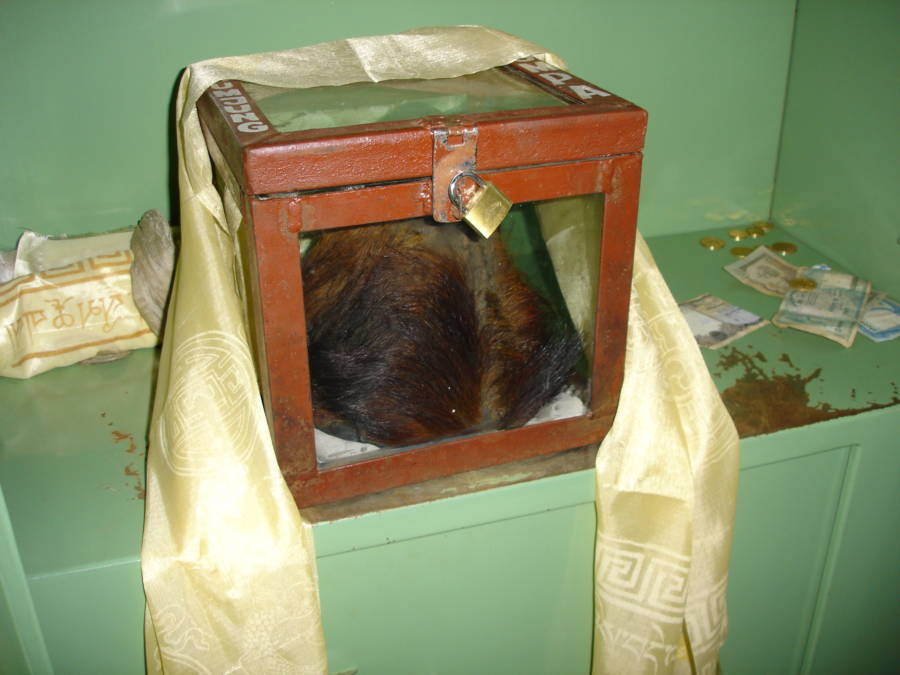
Nuno Nogueira/Wikimedia Commons The alleged Yeti scalp of Nepal’s Khumjung monastery, introduced to the Western world by famed explorer Edmund Hillary.
Two years later, building upon Shipton’s reconnaissance, Edmund Hillary of New Zealand and Nepalese Sherpa Tenzig Norgay completed what is perhaps history’s greatest feat of exploration when they became the first people to summit Everest.
But while Hillary’s mountaineering is known the world over, few realize that he was also, for a time, one of the world’s foremost Yeti hunters.
In the course of Hillary’s historic ascent, he claims to have spotted mysterious footprints in the snow on the Barun Khola mountain range, which Norgay believed came from a Yeti. However, unlike Shipton, Hillary didn’t photograph them, leaving that alleged Yeti evidence (along with the Yeti hair he’d supposedly found in the Himalayas the year before) lost to history.
In 1960, Hillary launched a full-fledged Yeti hunting expedition into the mountains of Nepal. While there, Hillary and his team visited a monastery in the village of Khumjung. There they acquired a purported Yeti scalp that had been in the village’s possession for over 200 years.
Upon Hillary’s return to London, the world was abuzz at this incredible piece of Yeti evidence — only to be let down after scientists quickly found that the “scalp” was actually the hide of a serow goat.
The “scalp” has since returned to the monastery, where it remains to this day.

PO Box 24091 Brooklyn, NY 11202-4091
Every print subscription comes with full digital access
Science News
Finally, some solid science on bigfoot.
DNA analysis finds weird bears, but no evidence of Sasquatch or the Abominable Snowman

Blurry photos have long been the main evidence for Bigfoot's existence. But a new genetic analysis finds that hair samples are everything but Bigfoot.
JoshNV/Flickr ( CC BY-NC-ND 2.0 )
Share this:
By Erika Engelhaupt
July 1, 2014 at 7:05 pm
Sometimes in science, you solve one mystery just to create another. So it goes with Bigfoot.
After creating a stir last October with preliminary results, an international research team has published an analysis of dozens of hair samples from mystery animals around the world. None reveal the existence of a yeti or Bigfoot, reports Bryan Sykes , an Oxford University geneticist well-known for his research on human evolution. But two hair samples point to a possible new and (you guessed it) mysterious species: a bear roaming the Himalayas that may be related to ancient polar bears.
Some Bigfoot hunters are thrilled anyway. “It’s quite exciting,” says Loren Coleman, director of the International Cryptozoology Museum in Portland, Maine. “This definitely shows there’s DNA in the Himalayas area of an unknown bear,” says Coleman, who embraces the use of a scientific approach to identifying creatures known only from legend. In 2013 his museum even named Sykes cryptozoologist of the year. (Crytozoologists search for animals unknown to science.)
Sykes says he started the project because he was “slightly irritated” that cryptozoologists kept saying they’ve been rejected by mainstream science. At the time, he was perfecting a technique for extracting mitochondrial DNA from a single hair shaft. “I realized I could do a proper scientific study,” he says. “I wasn’t looking for a yeti or anything like that. I was just going to do a scientific review of the evidence.”
And a less mainstream question lurked at the fringes of Sykes’ thoughts: “I’ve always been interested to know whether the Neanderthals and other types of humans became extinct,” he says. Having studied the DNA of ancient human relatives, he was fascinated by the idea that mysterious large mammals reported around the world might be tiny remnant pockets of some human relative. He decided to analyze the DNA of purported yeti samples, thinking there was maybe a 5 percent chance that he would find something interesting, maybe a new mammal species. And maybe a tiny sliver of a chance he’d find something even more surprising.
So in 2012 Sykes and his colleague Michel Sartori of the Museum of Zoology in Lausanne, Switzerland, posted a call for hair and other samples thought to be from yetis, Bigfoot or any other “cryptid” species unknown to science. The researchers would compare stretches of DNA to known species in the GenBank database, which catalogs thousands of species.
In came the hairs. There were hairs from famous expeditions, including a trek by Sir Edmund Hillary, hairs from museums, Buddhist relics, and, Sykes says, “quite a lot of material from Bigfoot enthusiasts in the United States.” Sykes whittled down 95 samples to 37 that were most interesting based on the circumstances of their collection.
Of those 37, the team was able to extract DNA from 30. “A lot of them turned out to be very ordinary animals in their natural habitats,” Sykes says. As the team reports July 1 in the Proceedings of the Royal Society B , supposed yeti and bigfoot samples turned out to come from bears (brown, black and polar), horses, raccoons, one human, some canines (the test didn’t narrow down if they were wolves or dogs), cows, sheep, a North American porcupine, a Malaysian tapir and a serow, which is a known animal similar to a goat or antelope.
But two hair samples from the Himalayas were a surprise. These hairs, both brownish in color, perfectly matched a short stretch of DNA once extracted from the jawbone of a 40,000-year-old polar bear. The hairs did not match modern polar bears. One hair came from an animal shot 40 years ago in Ladakh, India, by a hunter who reported that it behaved differently from typical brown bears. The other was collected about 10 years ago in Bhutan, 600 to 800 miles from Ladakh.
The researchers’ best guess is that the hairs are from either an unknown bear species or a hybrid of a brown bear and a polar bear. Such hybrids are known in the Arctic, but genetically resemble modern, rather than ancient, polar bears. If there’s a Himalayan hybrid, it might have descended from a different, long-ago liaison between the species. But since the match between the two hairs and the ancient polar bear resulted from a fragment just 104 DNA letters long, the result is preliminary, and the team hopes to do further analysis. Sykes is even planning an expedition to Ladakh to search for live bears.
“They’re from opposite ends of the Himalayas, so it’s reasonable to imagine that there might be some still alive in between,” Sykes says. He doesn’t think the samples are a hoax, since they were collected decades and hundreds of miles apart and were provided to Sykes by different sources. Plus, only the ancient jawbone is a genetic match.
If there is a previously unknown bear species living in the Himalayas, it may be what people there have seen and reported as a yeti. Coleman says that would be consistent with those reports. “They’re always brown,” he says. The idea of a white “abominable snowman” came from TV shows like Rudolph the Red-Nosed Reindeer .
Publishing data in a respected, peer-reviewed journal is a big step for cryptozoology, even if it means finding out that yetis don’t exist. In fact, especially if it means finding out that yetis don’t exist. By subjecting samples to genetic testing, Bigfootologists risk dashing their hopes. And any scientist taking on the task may risk his or her reputation. (Sykes says he wasn’t worried what colleagues would think of his new pursuit: “I’m in the cocktail hour of my career.”)
Maybe more scientists would be willing to test “cryptid” samples, but it takes money and time. No scientist working at a university or lab capable of genetic analysis has “testing Bigfoot samples” in their job description, it’s probably safe to say. Plus, it cost Sykes $2,000 to analyze each ‘yeti’ DNA sample, and not many Bigfoot enthusiasts are keen to pay. Part of Sykes’ work was paid for by a filmmaker, but he paid for the rest himself (and points out that no government funding was used).
Finding a new bear rather than a humanlike primate may be a letdown for some Bigfootologists. But not Loren Coleman. “I’m not disappointed. The whole role of science is to keep searching. We need to have patience,” he says.
And Sykes points out that he hasn’t actually disproven that the animals exist. There’s always some chance, however small, that the right sample just hasn’t been collected. Now, he says, Bigfoot chasers “can go back into the forest knowing that if they get a genuine sample it can be identified, and to a standard that everyone will accept.”
And if the next round of samples don’t turn up yetis, or the next after that, so be it. Maybe we’ll find something interesting anyway, like more new bears. Cryptozoologists like to point to the weirdly striped okapi that was once thought to be mythical. And then there are the recent discoveries of the lesula and olinguito .
Either way, the true Bigfoot believers will undoubtedly keep on believing, even if they embrace the scientific method. After all, the fun of science lies not just in finding answers, but in the thrill of the chase.
Follow me on Twitter: @GoryErika
More Stories from Science News on Genetics

Child sacrifices at famed Maya site were all boys, many closely related

Horses may have been domesticated twice. Only one attempt stuck

Scientists are fixing flawed forensics that can lead to wrongful convictions

Thomas Cech’s ‘The Catalyst’ spotlights RNA and its superpowers

50 years ago, chimeras gave a glimpse of gene editing’s future

The largest known genome belongs to a tiny fern
Here’s why some pigeons do backflips.

A genetic parasite may explain why humans and other apes lack tails
Subscribers, enter your e-mail address for full access to the Science News archives and digital editions.
Not a subscriber? Become one now .

29 Great Yeti Facts
Written by Rebekah Little
Modified & Updated: 30 May 2024
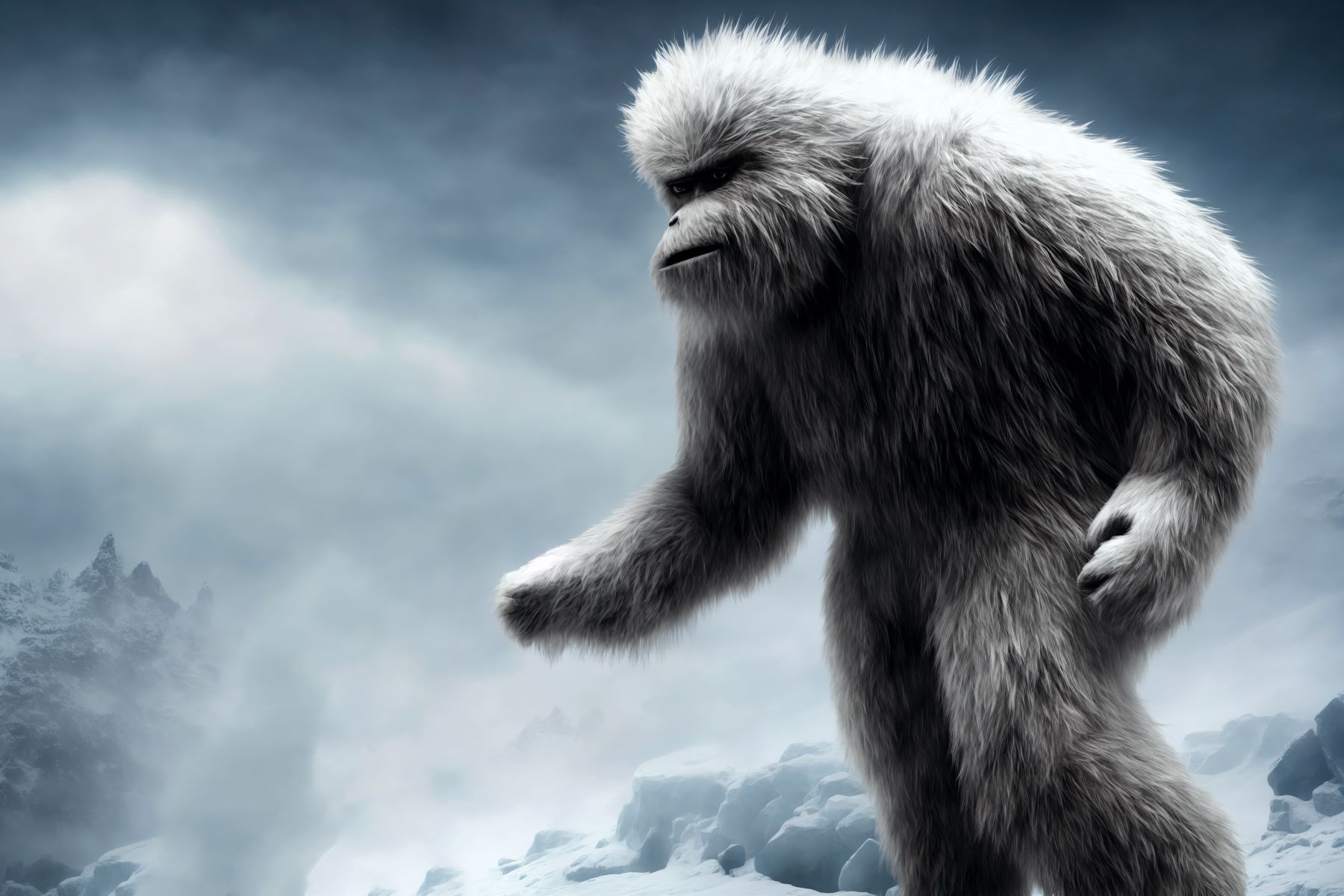
Ever wondered about the mysterious Yeti, often dubbed the Abominable Snowman? This elusive creature, said to roam the snowy peaks of the Himalayas, has captured imaginations and sparked debates worldwide. Is the Yeti real or just a myth? Well, hold onto your hats, because we're about to dive into 29 fascinating facts about the Yeti that might just make you a believer—or at least, give you something intriguing to ponder. From ancient legends to modern-day sightings and scientific investigations , the story of the Yeti is a rollercoaster of mystery and intrigue. Ready to get the lowdown on one of the most enigmatic figures in folklore? Let's get started on this wild ride through the snowy unknown!
Key Takeaways:
- The Yeti, also known as the "Abominable Snowman," is a mythical creature from the Himalayas, inspiring scientific investigations, cultural impact, and even tourism.
- Despite lack of concrete evidence, the legend of the Yeti continues to captivate human imagination, fueling expeditions, art, and conservation efforts in the Himalayas.

What Exactly is a Yeti?
Often referred to as the "Abominable Snowman," a Yeti is a mythical creature said to inhabit the Himalayan mountains. This elusive being has captured human imagination for centuries, with numerous expeditions undertaken to prove its existence. Despite the lack of concrete evidence, stories and supposed sightings continue to fuel the legend of the Yeti.
- Yeti is a term that comes from the Tibetan language, meaning "rocky bear."
- Locals in the Himalayas regard the Yeti not just as a myth but as a part of their rich folklore and culture.
Historical Sightings and Evidence
Throughout history, various explorers and locals have claimed to encounter the Yeti, providing a mix of anecdotal evidence and physical "proofs" like footprints in the snow.
- One of the earliest recorded Yeti sightings was by British explorer Charles Howard-Bury in 1921 during an expedition to Mount Everest.
- In 1951, Eric Shipton captured one of the most famous photographs of alleged Yeti footprints, sparking worldwide interest.
Scientific Investigations into the Yeti
Scientists have long been intrigued by the legend of the Yeti, leading to numerous studies and DNA analyses of supposed Yeti samples.
- Most DNA analyses of "Yeti" samples, such as hair or skin, have identified them as belonging to known animals like bears.
- A comprehensive study in 2017 analyzed multiple supposed Yeti artifacts and concluded most were from bears native to the area.
Cultural Impact of the Yeti
The Yeti has not only been a subject of folklore but has also influenced popular culture, appearing in movies, books, and even marketing campaigns.
- The Yeti has been featured in numerous films and television shows, often depicted as a misunderstood creature.
- Merchandise and products, including toys and video games, have been inspired by the Yeti, showcasing its impact beyond folklore.
The Yeti in Modern Expeditions
Despite the scientific community's skepticism, expeditions to find the Yeti continue, fueled by adventurers and enthusiasts hoping to uncover the truth.
- Expeditions in the 21st century have utilized modern technology, like drones and thermal cameras, in hopes of finding evidence of the Yeti.
- Although no conclusive evidence has been found, these expeditions often discover new information about the Himalayas' biodiversity.
The Yeti and Environmental Conservation
Interestingly, the legend of the Yeti has played a role in promoting environmental conservation in the Himalayas.
- Efforts to find the Yeti have led to increased awareness and interest in the conservation of its supposed habitat.
- Some conservation campaigns have used the Yeti as a symbol to promote the protection of endangered species in the region.
The Yeti in Art and Literature
The enigmatic nature of the Yeti has made it a fascinating subject for artists and writers, inspiring a variety of creative works.
- Numerous books, both fiction and non-fiction, have explored the mystery of the Yeti, contributing to its mythos.
- Artists have depicted the Yeti in various forms, from fearsome to friendly, reflecting its complex role in human culture.
The Yeti and Tourism
The mystery surrounding the Yeti has also become a tourist attraction, with many travelers visiting the Himalayas in hopes of a sighting.
- Tours and treks promising a chance to search for the Yeti attract adventure seekers from around the world.
- Museums and exhibitions in the Himalayas feature Yeti-related artifacts, drawing in curious visitors.
The Yeti in Science Fiction and Fantasy
The Yeti's appeal extends into the realms of science fiction and fantasy, where it often represents the unknown and the possibility of undiscovered creatures.
- Science fiction stories have used the Yeti as a symbol of nature's mysteries and the limits of human knowledge.
- In fantasy literature, the Yeti is sometimes portrayed as a guardian of ancient secrets or a being with magical powers.
The Yeti's Influence on Cryptozoology
Cryptozoology, the study of creatures whose existence is not substantiated by mainstream science, counts the Yeti among its most intriguing subjects.
- The Yeti is considered a "cryptid," a creature of folklore that has yet to be scientifically validated.
- Cryptozoologists continue to collect and examine evidence, hoping to prove the existence of the Yeti.
The Yeti and Global Folklore
The Yeti is just one example of a global phenomenon where cultures have legends of mysterious creatures inhabiting their wilds.
- Similar creatures to the Yeti, like North America's Bigfoot or the Australian Yowie, suggest a universal human fascination with the unknown.
- These legends often serve to explain phenomena that ancient peoples found mysterious or frightening.
The Future of Yeti Research
As technology advances, so do the methods available for searching for the Yeti, offering new hope to those convinced of its existence.
DNA testing and environmental DNA (eDNA) analysis offer promising tools for identifying unknown species in the Himalayas.
Satellite imagery and remote sensing technology could potentially uncover evidence of the Yeti's existence from afar.
Despite skepticism, interest in the Yeti remains strong, with new generations of explorers and scientists drawn to its mystery.
The Yeti's enduring legend continues to inspire curiosity and wonder, bridging the gap between myth and reality.
As long as the Himalayas remain vast and largely unexplored, the legend of the Yeti will persist, captivating the imaginations of people worldwide.
The quest for the Yeti not only fuels adventure but also brings attention to the rich biodiversity and cultural heritage of the Himalayas.
Ultimately, whether or not the Yeti is ever found, its story is a testament to the human spirit's quest for discovery and understanding of the natural world.
A Final Peek at the Mystical Yeti
Diving into the world of the Yeti has been nothing short of an adventure. We've uncovered 29 fascinating facts about this elusive creature, each adding a layer to its enigmatic existence. From its deep roots in Himalayan folklore to the intriguing evidence that keeps the scientific community on its toes, the Yeti remains a captivating subject. Whether it's the allure of the unknown or the thrill of the hunt that draws you in, one thing's for sure: the Yeti continues to hold a special place in the realm of cryptids. As we close this chapter, remember, the Yeti isn't just a tale of myth and mystery; it's a testament to humanity's enduring fascination with the wonders of our world. So, keep your eyes peeled and your mind open – who knows what discoveries lie just around the corner?
Frequently Asked Questions
Was this page helpful.
Our commitment to delivering trustworthy and engaging content is at the heart of what we do. Each fact on our site is contributed by real users like you, bringing a wealth of diverse insights and information. To ensure the highest standards of accuracy and reliability, our dedicated editors meticulously review each submission. This process guarantees that the facts we share are not only fascinating but also credible. Trust in our commitment to quality and authenticity as you explore and learn with us.
Share this Fact:
- YETI Holdings-stock
- News for YETI Holdings
Buy Rating on Yeti Holdings: Strategic Product Expansion and Attractive Valuation
In a report released yesterday, Randal Konik from Jefferies maintained a Buy rating on Yeti Holdings ( YETI – Research Report ), with a price target of $54.00 .
Randal Konik has given his Buy rating due to a combination of factors surrounding Yeti Holdings’s recent product developments and the company’s strategic positioning. Konik notes Yeti’s successful product launch cycle, exemplified by the release of the ROADIE 15 cooler, as a key driver for growth. The company has consistently leveraged its ability to expand product colorways and sizes, which enhances customer engagement and drives incremental sales. This approach not only broadens the appeal of Yeti’s existing product lines but also reinforces the brand’s competitive edge while it continues to diversify its product offerings into new market segments such as barware, culinary items, and luggage.
Furthermore, Konik’s analysis points to the attractive valuation of Yeti’s shares, which are currently trading at a significant discount relative to the company’s historical average price-to-earnings ratio. The stock is trading around 14 times forward earnings, compared to a five-year average of approximately 22 times, suggesting a potential undervaluation. His price target is based on an 18 times multiple of projected FY’25 earnings per share, indicating confidence in the company’s future financial performance. Additionally, Konik’s positive outlook is supported by his recent interactions with Yeti’s management, which have further reinforced his optimistic view on the company’s trajectory.
TipRanks tracks over 100,000 company insiders, identifying the select few who excel in timing their transactions. By upgrading to TipRanks Premium, you will gain access to this exclusive data and discover crucial insights to guide your investment decisions. Begin your TipRanks Premium journey today.
Yeti Holdings (YETI) Company Description:
YETI Holdings, Inc. engages in the design, marketing, and distribution of products for the outdoor and recreation market. Its products include coolers, drinkware, travel bags, backpacks, multipurpose buckets, outdoor chairs, blankets, dog bowls, apparel, and accessories. The company was founded by Roy J. Seiders and Ryan R. Seiders in 2006 and is headquartered in Austin, TX.
Read More on YETI:
- Yeti price target raised to $54 from $52 at Piper Sandler
- Yeti price target raised to $49 from $48 at Raymond James
- Yeti Holdings Shareholders Approve Compensation Plan, Elect Directors
- Yeti price target raised to $43 from $38 at TD Cowen
- Yeti price target raised to $42 from $40 at Canaccord
YETI Holdings News MORE
Related Stocks
- Best Whiskey
- Best Gym Shoes
- Best Pocket Knives
- Best Apple Watch
- Porsche Models

Behind the Scenes of Yeti’s Top Secret Innovation Center
For Yeti to stay ahead, it had to invest in its own future.
By Emily Singer
A version of this article originally appeared in Issue Five of Gear Patrol Magazine with the headline “Beyond the Cooler” Subscribe today
It seems impossible that something as mundane as a cooler could become a status symbol among fishermen, rodeo cowboys and tailgating college students. But since 2006, Yeti has been creating products that are so singular in their durability, they manage to transcend their intended purpose.
Yeti’s flagship cooler, the Tundra, wraps two inches of pressure-injected polyurethane insulation inside a virtually indestructible, certified-bear-proof rotomolded plastic body. For the launch of the product, Yeti created a series of YouTube videos pitting the Tundra against a 500-pound strongman, a grizzly bear, fireworks and a supersized slingshot. In all instances, the hard-sided cooler was little more than lightly scuffed — and still wholly functional.
The Tundra’s much-lauded ice retention was, in many ways, a secondary priority. Yeti founders Roy and Ryan Seiders were most concerned with creating a more durable casting platform for their fishing skiff — an alternative to the breakage-prone mass-market coolers they had long been using. Yeti spent two years iterating and improving upon its original hard cooler before arriving at the Tundra in 2008. A decade after Yeti’s founding, the company was valued at $5 billion. The Tundra remains its most recognizable product, and durability continues to form the backbone of everything it creates.
But for Yeti to grow, it couldn’t spend two years perfecting every new product. Prototyping services and destruction testing were outsourced; the back-and-forth communication and sample development took time. Bringing both product development and testing in-house would not only streamline Yeti’s operations, but accelerate them. It would allow the brand greater control over its products, and open doors for what Yeti could create.
5 original photos

And so in August 2016, after more than two years of planning, Yeti opened its Innovation Center, a dedicated prototyping and product-development facility. The unmarked building sits in a corporate office park shared with an engineering lab, a few miles down the road from Yeti’s headquarters in Austin, Texas. The building’s one-way windows conceal a dedicated 10-person product-development team and millions of dollars of equipment — high-powered, complex machinery that most consumer-products companies would only dream of owning.
Yeti’s Rambler drinkware is marketed as “virtually indestructible.” But under 14,000 pounds of force, the insulated stainless steel tumbler crimps down into condensed ridges until it resembles the body of a soup can. Such power is hard to generate short of using a hydraulic press; the only way to see a Yeti product — any of its products — in such a state is to visit the Innovation Center. And even then, Yeti is notoriously protective, to the point of being secretive, of the circumstances in which the remains of destructive testing are seen, and by whom. It’s not just consumers that Yeti is cautious around; only a handful of Yeti employees are aware of the Innovation Center’s existence, and even fewer have access to it.
“What we wanted to do was bring [prototyping and product testing] capabilities into Yeti with the idea that it would significantly speed up the iterative process of design,” CEO Matt Reintjes explains. Previously, the few 3D printers and assorted prototyping machines Yeti owned were housed in any closets, corners and hallways that could be claimed at the company’s headquarters. The 20,000-square-foot, high-ceilinged Innovation Center comes as a dramatic upgrade. “It also gives us the ability to bring what we believe is better innovation to the market. It’s about the speed of development — being able to move products more quickly through the design process. It was a way to control our design and protect our [intellectual property],” Reintjes adds.
As Yeti has gained prominence, copycat brands have emerged. The company has sued both retailers and competitors for patent infringement — Walmart and The Home Depot for selling imitations of its Rambler drinkware, and Bayou Ice Boxes, Mammoth Coolers, and RTIC, among others, for too closely mirroring the Tundra. “We vigorously and actively defend our intellectual property,” Reintjes says. “But we believe that the offensive strategy is to continue to be the innovation leader and to stay ahead.” The Innovation Center has become Yeti’s secret weapon. New designs and materials are contained under one roof until just before launch, allowing Yeti unprecedented control over its products.
With a mix of hand-built customs and manufacturer-made machinery, the space was developed to be maximally versatile — to prototype and test anything; future products and categories included. Speed, too, was a priority. “The number of iterations in testing, prototyping, validation and re-testing has increased dramatically,” says Director of Engineering Scott Barbieri. In the time since Yeti opened the Innovation Center, more than 2,800 distinct prototypes have been produced, with an average of 10–15 each day. A new Rambler silhouette can be generated in wax using a lathe in as little as 30 minutes. Soft-goods patterns, like those used in Yeti’s Hopper Flip coolers, can be laser cut from fabric and sewn into form in a matter of hours. “Previously, prototypes were outsourced to different vendors, taking weeks to turn around,” he adds. “Testing was done at outsourced labs, manufacturer’s labs or at the office sink.” Relying on outside companies left Yeti vulnerable to leaks, and forced the company to relinquish a degree of control over product testing.
Of all the equipment in Yeti’s arsenal, 3D printers, housed together in a walk-in-closet-sized room, have proven to be its most important — and costliest — investment. “[They] speed up our process and also bring products closer to reality,” Barbieri says. With enhanced prototyping capabilities, Yeti is able to create test products that echo the quality of factory samples. Adjusting the size or shape of a design that doesn’t pass muster is as simple as pushing pixels or changing a line of code and resubmitting the file. “Before anyone else in the world sees [a product], we’re able to design it, build it, test it here and have the full design package ready to go,” Barbieri says. The capacity to create higher-quality prototypes earlier in the development process eliminates risk down the road, enabling a previously unprecedented level of confidence in a product’s readiness when it ultimately launches.
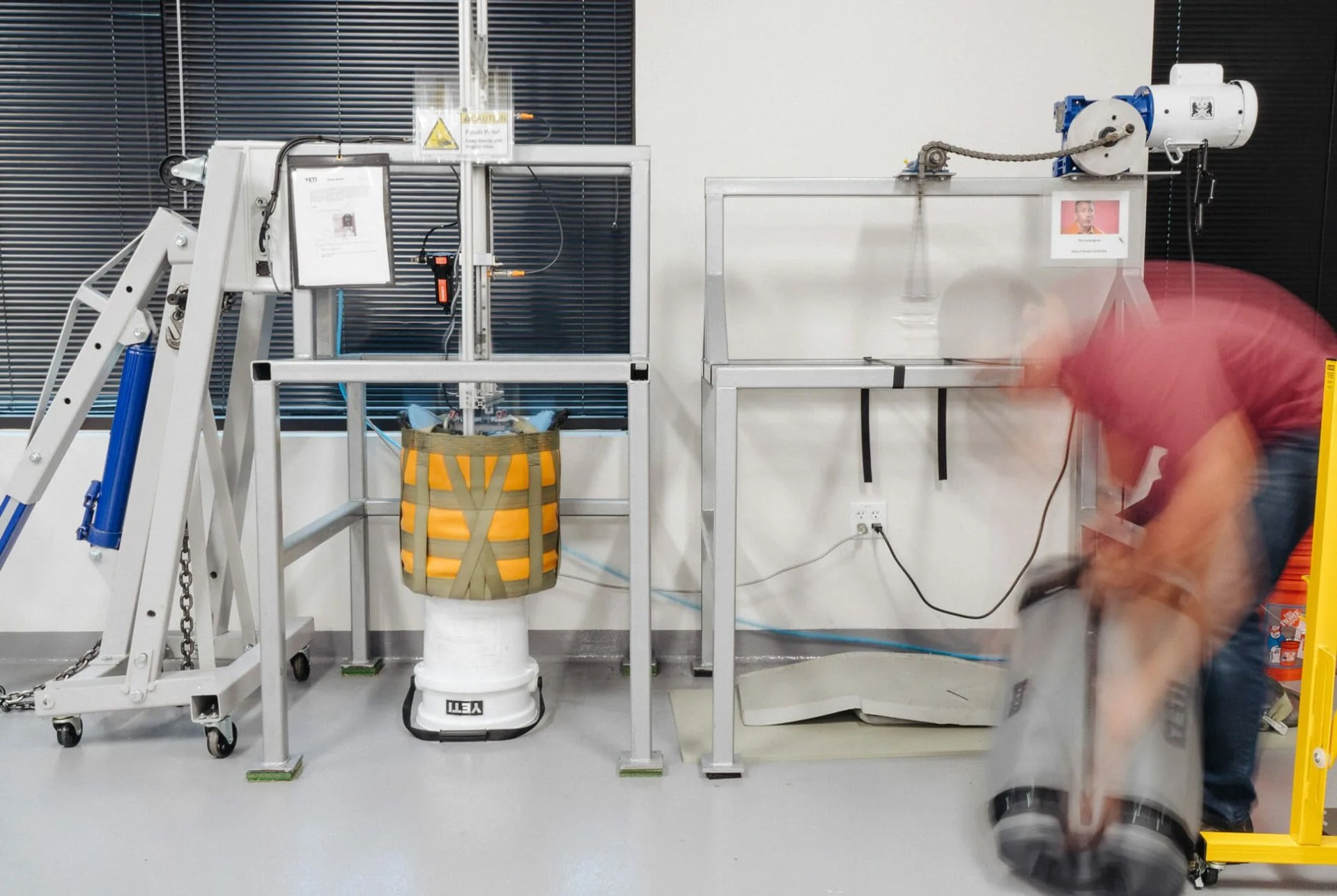
In addition to prototyping tools, the Innovation Center houses machines for what Barbieri calls “torture tests,” custom programmed to push Yeti’s products and their individual components to their breaking points. Yeti’s YouTube videos documenting outlandish efforts to destroy its products are made for customer enjoyment; the real destruction happens behind closed doors, off-camera and in a controlled environment — and is much less sexy. Robotic arms put zippers, lids and clasps through their paces 20,000 times in order to mimic a lifetime of use, checking for signs of failure every 1,000 cycles. To test for weather-related deterioration, exterior fabrics and plastics are exposed to months of UV light and humidity, selected to simulate the Florida Everglades, as well as temperatures as low as -30 and as high as 140 degrees Fahrenheit. “All those things that we found out about the Tundra after years and years in the field, we can find out quicker because of the automation and the tools that we have — to make sure that we keep our promise of quality and durability to our consumer,” says Yeti Marketing Director Bill Neff.
Before a product goes to market, Yeti puts prototypes in the hands of its brand ambassadors, all of whom are professional outdoor enthusiasts, for testing. While torture tests reveal breaking points, ambassadors provide insight into the practical nature of Yeti’s products, like the utility of straps or placement of zippers. The newly accelerated design process now gives Yeti the opportunity to involve brand ambassadors in foundational discussions around product development, according to Soft Goods Category Manager Alex Baires. “A big piece of that is just collecting feedback, sitting around a table, asking what’s working, what they’re using and how they’re using it. And some of those conversations result in product ideas for us to look into.” Videographer, surfer and all-around outdoorsman Keith Malloy has worked with Yeti in a product-testing capacity for two years. More than anything else, he says, the Innovation Center shows Yeti’s “dedication and commitment to making the best product possible.”
As Yeti’s product roster has grown, the company has been able to build a catalog of proven methods and materials; this, in turn, helps to streamline product development. In July, Yeti unveiled its first non-insulated pieces: the Panga airtight submersible duffel and the LoadOut bucket. They were among the first products developed in the Innovation Center, and the first manifestations of Yeti’s new prototyping abilities. The LoadOut wasn’t conceived until late 2016, and the Panga, which requires radio frequency welding to bond a watertight zipper to the exterior fabric, “would not have even been considered [for] development in-house due to the specific nature of its construction,” according to Barbieri.
The new products are a departure from what Yeti is known for, but their development was aided and accelerated by materials and methods that Yeti had proven in earlier products.
The Panga was created, in part, after Yeti learned that customers were using its Hopper soft-sided cooler as a dry bag. Building a dry bag could have been as simple as producing a non-insulated version of the Hopper, but Yeti has never been known to take the simple route. “Having something that’s proven doesn’t preclude us from trying other things,” says Baires. “We can have something that works extremely well, but if the application is a bit different, we want to make sure it’s right for that application . . . . We want to keep our options open to make sure we’re not ignoring or discounting something that could be better.” In addition to a similar thermoplastic polyurethane fabric, the Panga and Hopper employ the same proprietary watertight HydroLok zipper — developed exclusively for Yeti by TIZIP and based on zippers that previously had only been used on medical field tents during the Ebola crisis in West Africa — and EVA-molded base. “We tried a couple of different things, but we [kept coming] back to the fact that what we’re doing now worked. It was validation that what we’re doing now is the best approach,” Baires says.
On the other end of the spectrum, the development of the five-gallon LoadOut bucket can be considered a return to Yeti’s origins. “[The five-gallon paint bucket] was something we were using to rinse off reels on our skiffs; it was something we were using to wash our boats,” Hard Goods Category Manager Dennis Zuck said at the unveiling of the LoadOut. “They lived in our lifestyles, but they didn’t really live that long.” In much the same way that the Tundra was a purpose-built reinvention of a product long met with frustration, the LoadOut redefined what a bucket could be. Neff conceded that while something as mundane as a bucket “threw people off,” the LoadOut was simply the result of Yeti paying attention to its audience. “We weren’t trying to convince people that this is what they need; it was us listening to frustrations with what people were already using,” he says.
7 original photos

As Yeti looks to the future, the Innovation Center will prove its most vital asset. “It creates an enormous amount of opportunity [in terms of] places we can go,” Reintjes says. “The hardest thing about being in a growth organization is [making sure] that you are focused on knowing what you should do and deciding what you shouldn’t do. We’ve got to [have] discipline around picking what to focus on and what we’re going to do, and make sure that it fits with the brand and our consumers.”
At the outset, Yeti appealed to hunting and fishing communities with coolers that boasted unprecedented durability. But as the company’s product line has expanded and its reputation spread, other groups — rodeo, barbecue and outdoor enthusiasts — have gravitated toward its tools. What unites the disparate individual needs of Yeti’s new so-called “lifestyle” groups is a hunger for authentic experience, Neff says. “[Each group does] different things, but they have similar traits about them, and it’s this restless spirit that we attach ourselves to because we feel that’s what embodies the ethos of the brand, and that leads us to wherever we’re going to go.” Yeti’s future, then, will be guided by solution-oriented tools built for maximum utility.
Rather than targeting a particular audience, Yeti takes a pursuit-agnostic approach to product design. “It’s about starting from the ground up [and] making a product as best as we can make it, with no compromises,” Baires says, citing the goal of “staying pure to the product.” That means eliminating unnecessary or overwrought details, and constructing a tool that’s familiar, but with renewed utility — an ethos that allows Yeti’s products to be interpreted and employed in any number of ways.
Yeti’s reputation has begun to precede its product. Superlative durability, whether in a bottle opener or hard-sided cooler, has come to be expected. As Yeti broadens its horizons by introducing new categories and attracting new audience segments, its signature marriage of premium materials and true-to-life utility will endure, if not strengthen. “We are significantly focused on how we continue to bring innovation to the market; and that innovation is going to come in a number of different styles,” Reintjes says pointedly. “Some of it is going to come through new categories . . . but they all tie back to this focus on performance, durability, quality, design.”
“We have products in our pipeline that are wholly new to us and have never been done,” he adds. “And they’re not sharing any common materials or design expertise other than the design ethos of Yeti.”
Indeed, Yeti has recently ventured beyond the cooler, launching a durable camp chair called the Hondo, in addition to expanding on the concept of the Panga with an unlined bombproof tote called the Camino. A quick web search also reveals that Yeti has filed a number of patents for products even further outside of its current purview. With each new category launch comes more irrefutable proof of not only the brand’s expansion into broader markets, but of the Innovation Center’s power as a catalyst for new growth. In Neff’s words, “It isn’t about evolving to just become a bigger company, but it is about evolving to put out better product in the marketplace so people can enjoy what they do just that much better.”

Related Topics
Ad-free. Influence-free. Powered by consumers.
The payment for your account couldn't be processed or you've canceled your account with us.
We don’t recognize that sign in. Your username maybe be your email address. Passwords are 6-20 characters with at least one number and letter.
We still don’t recognize that sign in. Retrieve your username. Reset your password.
Forgot your username or password ?
Don’t have an account?
- Account Settings
- My Benefits
- My Products
- Donate Donate
Save products you love, products you own and much more!
Other Membership Benefits:
Suggested Searches
- Become a Member
Car Ratings & Reviews
2024 Top Picks
Car Buying & Pricing
Which Car Brands Make the Best Vehicles?
Tires, Maintenance & Repair
Car Reliability Guide
Key Topics & News
Listen to the Talking Cars Podcast
Home & Garden
Bed & Bath
Top Picks From CR
Best Mattresses
Lawn & Garden
TOP PICKS FROM CR
Best Lawn Mowers and Tractors
Home Improvement
Home Improvement Essential
Best Wood Stains
Home Safety & Security
HOME SAFETY
Best DIY Home Security Systems
REPAIR OR REPLACE?
What to Do With a Broken Appliance
Small Appliances
Best Small Kitchen Appliances
Laundry & Cleaning
Best Washing Machines
Heating, Cooling & Air
Most Reliable Central Air-Conditioning Systems
Electronics
Home Entertainment
FIND YOUR NEW TV
Home Office
Cheapest Printers for Ink Costs
Smartphones & Wearables
BEST SMARTPHONES
Find the Right Phone for You
Digital Security & Privacy
MEMBER BENEFIT
CR Security Planner
Take Action
Does the Yeti Rambler Deserve All the Love It Gets?
Consumer Reports tested this insanely popular travel mug to see if it lives up to the hype

It feels like there are only two kinds of coffee drinkers left in America: Those who love their Yeti Ramblers, and those who are tired of hearing about how much people love their Yeti Ramblers. Something about this travel mug seems to transform even the most casual users into instant brand ambassadors.
In fact, the mug is such a hit that it now accounts for about two-thirds of Yeti’s sales, far surpassing its sales of premium coolers—the product that made Yeti a household name.
While there’s no industry data tracking the best-selling travel mugs, it’s clear that Yeti is heading for world domination: “The Yeti Rambler is one of the most widely searched-for mugs online,” says Nish Suvarnakar, CR’s market analyst for the category. It’s also the top-selling tumbler on Amazon, where it has over 91,000 reviews. Yep, that’s three zeros.
The Rambler has 4.8 out of 5 stars on Amazon, with a review section loaded with fawning fans who describe their Ramblers as “incredible,” “worth every penny,” and “the perfect mug for a coffee snob!”
All this begs the question: What, exactly, is so amazing about the Yeti Rambler? To find out, we did what we do best. We tested it. We also tested nine other mugs from brands like Contigo, Starbucks, and Thermos. How did the Rambler stack up against its competitors? Read on to find out. For more on the travel mugs in our tests, see our ratings of insulated travel mugs .
Yeti Rambler Vitals
The Rambler is a hefty-feeling stainless steel mug, sold in about a dozen shapes and in capacities ranging from 10 to 30 ounces, for $12 to $35. We tested the 20-ounce Rambler, which is available in about 20 colors. You can add monogramming, custom words, or logos. The Rambler comes with a five-year warranty. Buy at: Ace Hardware , Amazon , Dick’s Sporting Goods , Lowe’s , Yeti
How the Yeti Rambler Fared in CR's Tests
Temperature Performance Perhaps the boldest claim Yeti makes for the Rambler is that it has vacuum insulation, “to protect your hot or cold beverages at all costs.” When CR’s test engineer Bernie Deitrick filled the Rambler with water heated to the temperature of freshly brewed coffee, he found that the Rambler kept liquids hot for 4½ hours.
“That might be plenty for most users, and enough to earn a rating of Very Good in our test, but it was far from the best,” Deitrick says. “We found eight other mugs that performed better than the Rambler, including a Zojirushi which kept water hot for 13½ hours, which is about three times as long as the Yeti.” Almost 14 hours is probably overkill for most coffee drinkers, and frankly, the 4½ hours you’ll get from the Rambler might be, too, but it’s also clear that the Rambler is far from the front of the pack.
Leaking and Spilling The Rambler isn’t a leakproof mug, but to be fair, it isn’t designed to be. The perimeter of the Rambler’s lid is wrapped with a rubber gasket, and the lid sits snugly atop a lip inside the mug. That precision fit keeps coffee from splashing, say, if you go over a speed bump while driving, and it slows any leaks if the mug is knocked onto its side, giving you the chance to turn the mug right side up before your coffee leaks all over the floor. Its simple magnetic opening mechanism allows you to sip easily, then close the latch.
Yeti makes clear that the Rambler isn’t leakproof, but we think it could fairly be called leak-resistant. For a lot of users, the Rambler’s design probably hits the sweet spot between easy sipping and a basic level of protection against the worst leaks. In our tests we found that things like extra latches, which help make a mug leakproof, also happen to make them a little more annoying to use—after all, it’s a pain to have to press a button or pop a cap up every time you take a sip of coffee.
Everyday Use and Cleaning It’s hard to find a mug that’s skinny enough to fit in a regular car cup holder but still easy to clean by hand. But the Rambler fits that bill.
That’s because it’s skinny where it needs to be. The Rambler’s tapered shape is slimmer at the base and wider at the top; it fit easily into the cup holders of four cars in our test—everything from a Toyota Prius to a Honda Pilot. And it was one of only two mugs that was a cinch to clean by hand—the others required a bottle brush.
The Rambler also has a design with almost no crevices, which limits the places coffee can linger—the mug didn’t hold on to nasty odors, even after we let coffee and cream sit in the mug and lid for 48 hours before washing.
The top of the mug has a rolled lip, so it’s comfortable to drink even without the lid in place. If you ever break or lose the lid, you can buy a replacement from Yeti for $10. And if you happen to lose or break the magnetic latch on the lid, you can buy just that piece for $3. Some manufacturers don’t offer replacement lids, or replacement parts at all, so you’d have to buy a whole new mug if something breaks.
The Bottom Line
To understand what makes the Yeti Rambler so special, you have to understand where other mugs fall short. Too many mugs feel like they’re designed with engineers in mind, not casual coffee drinkers. They’re built to be beautiful, or to keep coffee hot at all costs, often resulting in designs that make the mugs downright annoying to drink from or clean.
In many ways, the Rambler feels like it was custom-made just for you. Every mug makes some trade-off in performance to improve convenience, or vice versa. The Yeti Rambler seems to nail those trade-offs.
It doesn’t keep coffee as hot as most other mugs, but it still keeps it hot for 4½ hours, which is plenty for most commutes. It isn’t leakproof or spillproof, but it’s heavy and sits firmly on a surface, plus it boasts a spill-resistant lid, all of which reduce the likelihood you’ll suffer a serious spill. That lid is also exceptionally easy to clean, not to mention easy to drink from. The 20-ounce Rambler also manages to be slender enough to fit in every cupholder we’ve tried, plus it can be cleaned by hand with a sponge.
Given all that, it’s easy to see why the Yeti Rambler has such devotees. It’s not the mug you’d want to take to the top of Mount Everest, but it could be just what you need for your commute.
When you shop through retailer links on our site, we may earn affiliate commissions. 100% of the fees we collect are used to support our nonprofit mission. Learn more .
Paul Hope is a senior multimedia content creator at Consumer Reports and a trained chef. He covers ranges, cooktops, and wall ovens, as well as grills, drills, outdoor power tools, decking, and wood stains. Before joining CR in 2016, he tested kitchen products at Good Housekeeping and covered tools and remodeling for This Old House magazine. You’ll typically find him in his old fixer-upper, engrossed in a DIY project or trying out a new recipe.
Sharing is Nice
We respect your privacy . All email addresses you provide will be used just for sending this story.
Stanley The Flowstate Quencher H2.0 Tumbler
Hydro flask 20 oz w/ flex sip, contigo byron 2.0 16 oz (2094843), starbucks 16 oz (insulated tumbler), bubba hero xl (20088), s'well traveler (13016-b19-52140), takeya 17 oz (51273), zojirushi 16 oz (she48za), zojirushi 16 oz, yeti rambler 20 oz, s'well commuter 16 oz, thermos stainless king 16 oz.
See All Ratings
Trending in Insulated Cups
Best Insulated Cups of 2024
How to Quit Plastic
How Often Should You Be Cleaning Your Beloved Stanley Tumbler?
Best Mother's Day Gifts Under $50
An official website of the United States government
The .gov means it’s official. Federal government websites often end in .gov or .mil. Before sharing sensitive information, make sure you’re on a federal government site.
The site is secure. The https:// ensures that you are connecting to the official website and that any information you provide is encrypted and transmitted securely.
- Publications
- Account settings
Preview improvements coming to the PMC website in October 2024. Learn More or Try it out now .
- Advanced Search
- Journal List
- Front Physiol
The True Story of Yeti , the “Abominable” Heterochromatic Gene of Drosophila melanogaster
Yuri prozzillo.
1 Pasteur Institute of Italy, Fondazione Cenci Bolognetti, Rome, Italy
2 “Charles Darwin” Department of Biology and Biotechnology, Sapienza University of Rome, Rome, Italy
Francesca Delle Monache
Diego ferreri, stefano cuticone, patrizio dimitri, giovanni messina.
The Drosophila Yeti gene (CG40218) was originally identified by recessive lethal mutation and subsequently mapped to the deep pericentromeric heterochromatin of chromosome 2. Functional studies have shown that Yeti encodes a 241 amino acid protein called YETI belonging to the evolutionarily conserved family of Bucentaur (BCNT) proteins and exhibiting a widespread distribution in animals and plants. Later studies have demonstrated that YETI protein: (i) is able to bind both subunits of the microtubule-based motor kinesin-I; (ii) is required for proper chromosome organization in both mitosis and meiosis divisions; and more recently (iii) is a new subunit of dTip60 chromatin remodeling complex. To date, other functions of YETI counterparts in chicken (CENtromere Protein 29, CENP-29), mouse (Cranio Protein 27, CP27), zebrafish and human (CranioFacial Development Protein 1, CFDP1) have been reported in literature, but the fully understanding of the multifaceted molecular function of this protein family remains still unclear. In this review we comprehensively highlight recent work and provide a more extensive hypothesis suggesting a broader range of YETI protein functions in different cellular processes.
Introduction
The eukaryotic genome is packaged into a highly condensed structure known as chromatin allowing cells to organize, compact and stabilize the genome into the nucleus. The first step of this process is achieved through nucleosome assembly which DNA into an 11 nm fiber that represents an approximate 6-fold level of compaction ( Luger et al., 2012 ). Nucleosomes are octamers consisting of H2A/H2B and H3/H4 dimers which wrap around 147 bp of DNA. To gain access to DNA for replication, transcription and repair, nucleosomes must be shifted in different positions, removed or newly loaded to the DNA.
ATP-dependent protein complexes are the “molecular machines” having the task to specifically arrange the nucleosomal state. Thus far, all ATP-dependent chromatin-remodeling complexes identified contain a catalytic subunit which is part of the SWI2/SNF2 superfamily of ATPases and utilize a Swi2/Snf2-type ATPase domain consisting of an ATP-binding domain (DExx-domain), together with a helicase domain (HELICc-domain) ( Clapier et al., 2017 ).
Four different classes (or families) of chromatin-remodeling complexes can be identified within chromatin remodeler ATPases superfamily: SWI/SNF, ISWI, CHD, and INO80 ( Clapier et al., 2017 ). This classification is based on the presence of additional motifs outside the ATPase region. SWI/SNF members contain a bromodomain, ISWI members contain a SANT domain, while a
chromo- and a DNA-binding domain is found in CHD members. The INO80 class members do not contain any of these domains; instead, the ATPase domain is splitted into two segments ( Lessard and Crabtree, 2010 ).
The process of chromatin remodeling generally refers to different changes in DNA–histone interaction within nucleosomes using the energy from ATP hydrolysis ( Becker and Horz, 2002 ). They include repositioning of histone octamers in cis (along the same DNA template molecule) and in trans (from one DNA template molecule to another one), the loss of superhelical torsion of nucleosomal DNA, and the increase in accessibility to nucleosomal DNA for downstream processes as transcription. Interestingly, recent studies have shown that ATP-dependent chromatin remodeling may allow to change the histone composition of a nucleosome ( Clapier and Cairns, 2009 ). Indeed, the yeast SWR1 complex, a member of the INO80 family, associates with Htz1, the homolog of mammalian histone variant H2A.Z. This complex can drive the ATP-dependent replacement of H2A–H2B with Htz1–H2B dimers ( Krogan et al., 2003 ; Kobor et al., 2004 ; Mizuguchi et al., 2004 ; van Attikum and Gasser, 2005 ) by Swc1 ATPase subunit. In vivo , SWR1 catalyzes the incorporation of Htz1 into chromatin, which prevents the spreading of heterochromatin regions into regions of euchromatin ( van Attikum and Gasser, 2005 ).
The human (SRCAP and P400/Tip60) and Drosophila (dTip60) orthologous chromatin remodeling complexes include proteins with high similarity to the subunits of two distinct chromatin-modifying complexes, the yeast NuA4 complex ( Wang et al., 2018 ) harboring HAT (Histone Acetyl-transferase) activity, and the SWR1 ATP-dependent chromatin remodeling complex which catalyzes histones exchange ( Table 1 ).
SWR1 subfamily.
| ATPase | EAF1 | SWR1 | Domino | EP400 | SRCAP | DOMO1, KIAA0309 | Histone-tail binding/ATP-dependent helicase |
| Non-catalytic homolougous subunits | RVB1 | Pontin | RUVBL1 | RUVBL1 | Pontin, ECP54, INO80H, NMP238, TIH1, Pontin52, TIP49, TIP49a | ATP-dependent helicase (unclear), scaffold | |
| RVB2 | Reptin | RUVBL2 | RUVBL2 | Reptin, ECP51, INO80J, Reptin52, TIH2, TIP48, TIP49b | ATP-dependent helicase (unclear), scaffold | ||
| ARP4 | ARP4 | BAP55 | ACTL6A | ACTL6A | Actl6, BAF53A, INO80K | Phospho-H2A-variant-dependent DNA recruitment upon DNA damage | |
| ACT1 | ARP6 | Act87E | Actin | ACTR6 | FLJ13433 | Positive regulation of ATPase activity, actin related | |
| ESA1 | Tip60 | KAT5 | cPLA2, PLIP, HTATIP1, ZC2HC5 | HAT activity | |||
| EAF3 | MRG15 | MORF4L1 | HsT17725, MEAF3, MORFRG15 | H3K36me2/3 binding | |||
| EAF6 | dEAF6 | MEAF6 | CENP-28, FLJ11730, NY-SAR-91 | Unknown | |||
| EAF7 | dMRGBP | MRGBP | FLJ10914, MRG15BP | MRG15-binding, potential DNA-binding | |||
| EPL1 | E(pc) | EPC1 | Protein-interaction within complex, regulation of HAT activity | ||||
| YNG2 | dING3 | ING3 | Eaf4, FLJ20089, MEAF4, p47ING3 | H3K4me3 binding | |||
| TRA1 | dTra1 | TRRAP | PAF400, TR-AP | Adaptor, scaffold | |||
| YAF9 | YAF9 | GAS41 | YEATS4 | YEATS4 | NuBI-1 | Transcriptional activation, nuclear matrix interaction | |
| SWC4 | SWC4 | dDMAP1 | DMAP1 | DMAP1 | DNMAP1, DNMTAP1, EAF2, FLJ11543, KIAA1425, MEAF2 | Histone-tail binding | |
| Bdf1 | dBrd8 | BRD8/TRCp120 | p120, SMAP | Binding to acetylated histones, transcriptional coactivator | |||
| VPS72 | YL-1 | VPS72 | VPS72 | H2A-variant binding | |||
| H2AZ, H2B | H2A.V, H2B | H2AZ, H2B | Unknown | ||||
| VPS71 | ZNHIT1 | p18/Hamlet | Unknown | ||||
| SWC5 | YETI | CFDP1 | BCNT, CENP-29, CP27, p97 | Unknown | |||
| Unique | EAF5, EAF1 | SWC3, SWC7 | Unknown | ||||
The dTip60 complex is made up by 14 core subunits (BAP55, dGAS41, dPontin, dReptin, Nipped-A, e(Pc), dYL1, dDMAP, Act87B, dMrg15, dMrgBP, dTRA1, dIng3, and dEaf6) and was found to be required for the replacement of acetylated phospho-H2A.V by unmodified H2A.V via Domino (Dom) ATPase ( Kusch et al., 2004 ; March-Diaz and Reyes, 2009 ). In Drosophila , H2A.V is the only H2A variant and corresponds to mammalian H2A.X and H2A.Z ( Baldi and Becker, 2013 ). Similarly to H2A.X, H2A.V is phosphorylated upon DNA double strand breaks to mark the DNA lesions, stimulate DNA repair machinery, and promote an easily accessible DNA conformation ( Kusch et al., 2004 ).
The human P400/Tip60 complex highly resembles the dTip60 complex and contains the p400 protein, which also shows high sequence similarity to SWR1, DOMINO and SRCAP ( Eissenberg et al., 2005 ; Table 1 ). Recent studies have demonstrated that several components of the P400/Tip60 complex are amplified or overexpressed in human neuroblastoma, glioblastoma, and colorectal cancer, while loss of function is mostly lethal, leading to cell growth arrest or cell death as well as genome instability ( Yamada, 2012 ).
The YETI protein was found to be a new subunit of Drosophila Tip60 remodeling complex ( Messina et al., 2014 ), arousing more and more curiosity because of a growing number of biological functions that it is supposed to perform.
Here, we comprehensively review emerging findings on YETI and its orthologous proteins in other species highlighting the broad-range involvement of these proteins in many biological processes.
The Biological Role of Yeti Protein
Y eti , previously called CG40218, is an essential 1717-bp-long gene located in the heterochromatin of chromosome 2 of Drosophila melanogaster required for proper chromosome organization in both mitosis and meiosis ( Hilliker, 1976 ; Corradini et al., 2003 ; Dimitri et al., 2003 ; Messina et al., 2014 ; Marsano et al., 2019 ). The evolutionary origin of Yeti gene is rather peculiar as such it has evolved from a euchromatic ancestor in drosophilids. The Yeti locus maps on euchromatin in two distantly related species, D. pseudoobscura and D. virilis indicating that over time (about 40 million of years, which is the estimated divergence time between D. melanogaster and D. virilis ) it progressively moved closer to the heterochromatic pericentromeric regions ( Moschetti et al., 2014 ; Caizzi et al., 2016 ). Interestingly, Yeti gene retained its original and robust organization in all analyzed species, with a short genomic region carrying a single short intron.
It is known that genes expressed at low levels harbor substantially shorter introns than those are expressed at high levels ( Castillo-Davis et al., 2002 ). Therefore, despite of the genomic re-location, Yeti may have been under selective pressure maintaining a short size and ensuring high and efficient gene expression during early development ( Moschetti et al., 2014 ).
YETI is a 241-aa-long protein belonging to BCNT protein superfamily which is characterized by a yeast-to-human highly conserved 82-amino acid domain located at the C-terminus (BCNT-C) ( Takahashi et al., 1998 ; Figure 1 ).

The YETI orthologous proteins. Blast alignments of YETI and its orthologous protein sequences from human ( H. sapiens ), mouse ( M. musculus ), bovine ( B. taurus ), chicken ( G. gallus ), Zebrafish ( D. rerio ) and yeast ( S. cerevisiae ). Note the high level of conservation (about 45% similarity) in the last 80 residues of the BCNT C-terminal domain (red line).
The YETI protein was originally identified as a both subunits kinesin-binding protein. In addition, Immunofluorescence experiments showed both a nuclear and cytoplasmic localization of V5 -tagged YETI in Drosophila S2 cells ( Wisniewski et al., 2003 ). However, these experiments failed to clarify whether YETI is located within the nuclei or associated with the nuclear membrane.
In the last decade, YETI protein functions have been investigated more in depth ( Messina et al., 2014 ). In particular, YETI was found to be a chromatin-associated protein member of the dTip60 complex ( Figure 2 ), whose depletion leads to larval stage lethality accompanied by profound perturbations of higher-order chromatin organization due to the failure in loading of histone H2A.V, nucleosomal histones, and chromatin marks. Moreover, the BCNT domain of YETI was found to be involved in chromatin binding through the interaction with the H2A histone variant (H2A.V), Domino-A (DOM-A) ATPase, and HP1a protein ( Ryu et al., 2014 ; Figure 3 ).

Subcellular YETI localization. (A) YETI::GFP fusion protein localizes in nuclei of salivary glands and (B) binds to polytene chromosomes. A nuclear immunolocalization of YETI protein is accordingly found in (C) spermatocytes, (D) elongated spermatids and (E) Drosophila S2 cells.

Interaction partners of YETI and its orthologs. YETI ( D. melanogaster ), hCFDP1 ( H. sapiens ) and SWR1 ( S. cerevisiae ) interacting proteins identified by using MIST (Molecular Interaction Search Tool). They refer only to physical interactions experimentally determined.
Taken together, these results strongly suggest that YETI may be directly implicated in the exchange of the variant H2A.V onto nucleosomes impacting on the dynamic changes of chromatin, and fulfilling its role as subunit of Tip60 chromatin remodeling complex, similarly to the yeast homolog SWC5 ( Morillo-Huesca et al., 2010 ).
Furthermore, in a genetic interaction map of cell cycle regulators, YETI (and also the DOMINO ATPase) has been defined as an additional interesting connection in the proximity of Anaphase-promoting complex/Cyclosome (APC/C) ( Billmann et al., 2016 ), suggesting a specific role in the regulation of chromatin and transcription during mitosis ( Morrison and Shen, 2009 ; Tanenbaum et al., 2015 ). Moreover, there are emerging evidence indicating that YETI is involved in synapse assembly and function ( Pazos Obregon et al., 2015 ).
In conclusion, YETI appears to be a multifaceted chromatin protein playing a key role in different cellular pathways.
The Molecular Function of Swc5, the Yeti Orthologous Protein in S. cerevisiae
Molecular insights of YETI orthologs come from other model organisms. For example, Swc5, the yeast ortholog protein, is a component of the SWR1 complex which catalyze the exchange of histone H2A with the H2A variant, Htz1 ( Kobor et al., 2004 ; Mizuguchi et al., 2004 ). However, although Swc5 protein is not essential, Swc5 null-mutants are defective in chromosome maintenance, and show decreased resistance to hydroxyurea (Saccharomyces Genome Database) and increased heat sensitivity ( Dastidar et al., 2012 ).
In vitro studies report that the binding of SWR1 complex to Htz1 is not dependent on Swc5 subunit, but Swc5 deleted mutants lack histone exchange function, indicating a key role of Swc5 during the histone replacement reaction ( Wu et al., 2005 ). In vivo evidence supports this conclusion showing that the absence of Swc5 doesn’t affect complex assembly while it nearly dropped down the amount of Htz1 bound to chromatin, suggesting that Swc5 is required for the binding and destabilization of the H2A/H2B dimer ( Morillo-Huesca et al., 2010 ). More in depth, SWR1 catalyzes H2A.Z in vitro replacement as one H2A.Z-H2B dimer at a time, generating heterotypic nucleosomes as intermediates and homotypic H2A.Z nucleosomes as final products. The SWR1 ATPase activity is specifically stimulated by H2A-containing nucleosomes, then free H2A.Z-H2B dimer leads to hyperstimulation of ATPase activity, eviction of nucleosomal H2A-H2B, and deposition of H2A.Z-H2B onto chromatin. In this way, SWR1 complex catalyzes nucleosomal conversion from H2A/H2A to Htz1/Htz1, with the heterotypic nucleosomes H2A/Htz1 as intermediates ( Luk et al., 2010 ). Furthermore, a truncated Swc5 lacking the BCNT domain is not able to restore the reaction, indicating that BCNT domain is required for Htz1 deposition ( Sun and Luk, 2017 ).
Craniofacial Development Protein 1 (CFDP1): a “Developmental Face” of Yeti Orthologs in Mammals
A 97 kDa BCNT protein (p97Bcnt) was first identified in bovine brain and found to be widely distributed in animals and plants ( Nobukuni et al., 1997 ; Takahashi et al., 1998 ; Iwashita and Naoki, 2011 ; Messina et al., 2015 ).
Later on, the murine ortholog was isolated and cloned from a mouse E11 (Embrional day 11) λgt11 library using an antibody against Cem1, a tooth cementum-related protein marker of a distinct expression pattern of mouse craniofacial development ( Diekwisch et al., 1999 ). It maps on chromosome 8 in the E1 region and is 85 kb long, with a 7 exons (888 nucleotides) open reading frame transcribing a single mRNA and encoding a 295 a.a. protein of 27 kDa weight (mCFDP1). Due to its expression pattern and protein MW, the gene was originally named craniofacial protein 27 ( cp27) ( Diekwisch et al., 1999 ).
Studies on the cp27 protein (later called mCFDP1) have shown specific interaction with NF-Y nuclear factor which bind CCAAT box ( Luan et al., 2010 ; Ito et al., 2011 ), and with the TFII-I transcription factors involved in craniofacial development and osteo-differentiation ( Makeyev and Bayarsaihan, 2011 ). Moreover, while RT-qPCR experiments revealed the presence of mCFDP1 in a pool of different genes related with transcription in osteo-differentiation ( Bustos-Valenzuela et al., 2011 ), Northern blot analysis, combined with an in situ hybridization, have confirmed high level of its expression in developmental stage of mouse embryos, and in particular in neuroepithelium, cerebellum, heart, lung, liver, teeth, salivary glands, and periosteum of developing bones. These data have been also confirmed by immunohistochemical staining of developing tissues ( Luan and Diekwisch, 2002 ).
Furthermore, cleft palate induction by persistent expression of PAX3 gene in neural crest correlates with cp27 downregulation ( Wu et al., 2008 ).
The human BCNT ortholog maps to chromosome 16 in 16q22.2- q22.3, in proximity to several loci associated with inherited craniofacial disease genes ( Diekwisch et al., 1999 ; Iwashita and Naoki, 2011 ). For this reason and for the expression pattern of the mouse ortholog it was called craniofacial development protein 1 gene ( Cfdp1 , OMIM number 608108). It is transcribed into two mRNAs differing by the alternative splicing-mediated inclusion or exclusion of exon encoding BCNT domain ( Messina et al., 2017 ).
Independent experimental evidence suggests that the human CFDP1 (hCDFP1) protein is a subunit of the SNF2-related CBP activator protein (SRCAP) chromatin remodeling complex ( Havugimana et al., 2012 ; Messina et al., 2017 ), which catalyzes the ATP-dependent replacement of canonical histone H2A with the H2A.Z variant ( Monroy et al., 2001 ).
The first pioneer work aimed to address the mechanistic functions of hCFDP1 protein have been performed ( Messina et al., 2016 ) by expressing human Cfdp1 transgene in D. melanogaster. The results of this experiment have shown that hCfdp1 expression lead to lethality and developmental and morphological defects, depending on the tissue-specific driver used. In particular, hCFDP1 binds to chromatin leading to abnormal polytene chromosome organization, decreased levels of H2A.V and H2A, brains and imaginal discs decreased size, developing of melanotic masses, prolonged larval stage and lethality. All these defects strongly resemble those produced by the lack of YETI ( Messina et al., 2014 ). Thus, it is conceivable that hCFDP1 over-expression in D. melanogaster disrupts the physiological function of YETI resulting in a dominant-negative effect. Reciprocally, the Drosophila 3xFlag:YETI expressed in HeLa cells is able to go into the cell nucleus, bind to chromatin and produce a substantial decrease in the mitotic index with an important defects of cell cycle progression ( Messina et al., 2016 ).
GST-pull down experiments have shown that both YETI and CFDP1 can undergo self-dimerization or hetero-dimerization. Thus, aberrant phenotypes could be due to the in vivo formation of YETI-CFDP1 non-functional hetero-dimers, together with a concomitant reduction of the amount of endogenous protein, YETI (drosophila cells) or CFDP1 (HeLa cells) ( Messina et al., 2016 ; Messina et al., 2017 ).
Moreover, RNAi-mediated depletion of hCFDP1 in HeLa cells led to aberrant morphology and condensation defects of mitotic chromosomes impacting on their normal segregation during mitosis ( Messina et al., 2017 ). These defects evoke those exhibited by Yeti null alleles in Drosophila melanogaster , suggesting a high-order chromatin organization maintenance function ( Cenci et al., 2003 ; Messina et al., 2014 ).
Interestingly, the chromosome condensation defects observed in CFDP1 depleted cells resemble those found in cells lacking the MCPH1 gene encoding microcephalin, which is one of the causative genes of primary microcephaly ( Yamashita et al., 2011 ; Messina et al., 2017 ).
Finally, in a human proteomic study, CFDP1 was found to interact with Ewing sarcoma related protein (EWSR1) whose mutations leads to Ewing’s sarcoma, a type of cancer that forms in bone or soft tissue ( Bode-Lesniewska et al., 2019 ; Figure 3 ).
Yeti Orthologs in Non-Mammalian Vertebrates
Among other vertebrates, data on YETI orthologs are only available from birds and fishes. In a recent study CENP-29, the chicken BCNT member, has been reported to be associated with kinetochores and therefore was suggested to play a role in chromosome segregation ( Ohta et al., 2010 ).
In Danio rerio , the BCNT family gene, previously called rltpr ( RGD motif, leucine-rich repeats , tropomodulin domain and proline-rich containing ) and recently renamed zCfdp1 , was found to be developmentally expressed in the eye, Central Nervous System and in branchial arches which lead to the craniofacial structures ( Thisse and Thisse, 2004 ).
Recently, Celauro et al. (2017) have shown that zCFDP1 is rapidly produced after Maternal-To-Zygote transition and it is highly enriched in the head structures. Moreover, depletion of zCFDP1, induced by an ATG-blocking morpholino , produces drastic defects in craniofacial structures and bone mineralization.
Together, these results show that, not only that zCFDP1 is an essential protein required for proper embryonal development, but more importantly, they provide the first experimental evidence that it directly implicated in the morphogenesis of craniofacial territories in vertebrates. Moreover, based on the high level of identity (about 70%) ( Figure 1 ), humans and zebrafish CFDP1 proteins, may be functionally conserved. It is then plausible that CFDP1, as a subunit of the SRCAP chromatin remodeling complex, participates to the epigenetic control of chromatin regions containing developmentally regulated genes, whose activation/silencing is crucial for proper differentiation of craniofacial structures and osteogenesis in zebrafish and likely in humans ( Celauro et al., 2017 ).
Emerging New Functions of Yeti and its Orthologs
As described above, the evolutionarily conserved Tip60 chromatin remodeling complex reveal multifaceted biological roles including transcriptional regulation, DNA repair, cell cycle progression, chromosome stability, stem cell maintenance and differentiation ( Sapountzi et al., 2006 ; Tea and Luo, 2011 ).
As anticipated, depletion of YETI and CFDP1 in D. melanogaster and HeLa cells respectively affects mitotic index and led to chromosome segregation defects ( Cenci et al., 2003 ; Messina et al., 2014 , 2016 ). Moreover, the chicken YETI ortholog CENP-29 has been reported to be associated with kinetochores in chicken ( Ohta et al., 2010 ). Finally, YETI protein has also been implicated in cell cycle control in both mitosis and meiosis ( Billmann et al., 2016 ). According with these results, it has been reported that Myc, a well-known oncogenic player ( Bellosta et al., 2005 ; Jonchere et al., 2017 ; Taylor et al., 2017 ), and the DOMINO ATPase interact each other and are required for normal asymmetric neuroblast (NB) division. Live-imaging analysis of dom -or myc -depleted NBs showed that spindle morphology is affected resulting in aberrant divisions ( Rust et al., 2018 ). Similarly, Tip60 acetyl-transferase and Myc have been shown to co-regulate genes functionally involved in cell cycle and DNA replication ( Zhao et al., 2018 ). Noteworthy, D. melanogaster mutants leading to symmetric division induce tumorigenesis ( Albertson and Doe, 2003 ; Lee et al., 2006 ). Similarly, mutants lacking centrosomes and have severely impaired spindle asymmetry, over-proliferate and form tumors ( Caous et al., 2015 ). Furthermore, mutations in genes encoding proteins directly or potentially implicated in chromatin biology are key players in human cancer and developmental disorders ( Bickmore and van der Maarel, 2003 ; Fog et al., 2012 ; Harmacek et al., 2014 ).
Previous findings highlighted a role of YETI in spermatogenesis ( Cenci et al., 2003 ). Accordingly, hCFDP1 has been found to physically interact with TALDO1 ( Perl et al., 2006 ; Huttlin et al., 2015 , 2017 ), an hallmark of human and murine spermatogenesis ( Berkovits and Wolgemuth, 2013 ; Green et al., 2018 ), and HIST1H2BA ( Figure 3 ), an intronless gene encoding a testis/sperm-specific member of the histone H2B family ( Zalensky et al., 2002 ).
Taken together, the above-mentioned studies suggest that YETI and its orthologs, in addition to their canonical functions in chromatin remodeling, may play yet unexplored roles during both mitotic and meiotic cell division.
Conclusion and Future Perspective
Most of the recent progresses in the study of the BCNT protein family originated from the functional analysis of a relatively small gene ( Yeti ) located in D. melanogaster constitutive heterochromatin, traditionally regarded as a transcriptionally inert or useless portion of the genome, albeit this prejudice has been debunked ( Marsano et al., 2019 ). The fallout produced by those studies is relevant to basic research on epigenetics and to biomedical research too, as suggested by the experimental evidence showing that CFDP1 actively participates to craniofacial development in zebrafish. Craniofacial malformations are indeed developmental disorders of biomedical and clinical interest, because they represent the main cause of infant mortality and disability in humans. Therefore, it is reasonable to include the Cfdp1 gene in the screening test for human syndromes showing alteration of craniofacial development.
Author Contributions
PD and GM conceived the concept of the study and wrote the manuscript. YP and GM designed and formatted the figures and table. All authors drafted the literature search, edited and reviewed the manuscript.
Conflict of Interest Statement
The authors declare that the research was conducted in the absence of any commercial or financial relationships that could be construed as a potential conflict of interest.
Acknowledgments
We would like to acknowledge BOXSHADE ( https://embnet.vital-it.ch/software/BOX_form.html ) for the layout of the amino acid alignment ( Figure 1 ).
Funding. This work was supported by Ricerche Universitarie 2017 (MIUR) (PD) and “Teresa Ariaudo” Research Program 2018–2020 from Pasteur Institute, Cenci Bolognetti Foundation (GM).
- Albertson R., Doe C. Q. (2003). Dlg, Scrib and Lgl regulate neuroblast cell size and mitotic spindle asymmetry. Nat. Cell. Biol. 5 166–170. 10.1038/ncb922 [ PubMed ] [ CrossRef ] [ Google Scholar ]
- Baldi S., Becker P. B. (2013). The variant histone H2A.V of Drosophila –three roles, two guises. Chromosoma 122 245–258. 10.1007/s00412-013-0409-x [ PubMed ] [ CrossRef ] [ Google Scholar ]
- Becker P. B., Horz W. (2002). ATP-dependent nucleosome remodeling. Annu. Rev. Biochem. 71 247–273. 10.1146/annurev.biochem.71.110601.135400 [ PubMed ] [ CrossRef ] [ Google Scholar ]
- Bellosta P., Hulf T., Balla Diop S., Usseglio F., Pradel J., Aragnol D., et al. (2005). Myc interacts genetically with Tip48/Reptin and Tip49/Pontin to control growth and proliferation during Drosophila development. Proc. Natl. Acad. Sci. U.S.A. 102 11799–11804. 10.1073/pnas.0408945102 [ PMC free article ] [ PubMed ] [ CrossRef ] [ Google Scholar ]
- Berkovits B. D., Wolgemuth D. J. (2013). The role of the double bromodomain-containing BET genes during mammalian spermatogenesis. Curr. Top. Dev. Biol. 102 293–326. 10.1016/B978-0-12-416024-8.00011-8 [ PMC free article ] [ PubMed ] [ CrossRef ] [ Google Scholar ]
- Bickmore W. A., van der Maarel S. M. (2003). Perturbations of chromatin structure in human genetic disease: recent advances. Hum. Mol. Genet. 12(Suppl. 2) , R207–R213. [ PubMed ] [ Google Scholar ]
- Billmann M., Horn T., Fischer B., Sandmann T., Huber W., Boutros M. (2016). A genetic interaction map of cell cycle regulators. Mol. Biol. Cell. 27 1397–1407. 10.1091/mbc.E15-07-0467 [ PMC free article ] [ PubMed ] [ CrossRef ] [ Google Scholar ]
- Bode-Lesniewska B., Fritz C., Exner G. U., Wagner U., Fuchs B. (2019). EWSR1-NFATC2 and FUS-NFATC2 gene fusion-associated mesenchymal tumors: clinicopathologic correlation and literature review. Sarcoma 2019 : 9386390 . 10.1155/2019/9386390 [ PMC free article ] [ PubMed ] [ CrossRef ] [ Google Scholar ]
- Bustos-Valenzuela J. C., Fujita A., Halcsik E., Granjeiro J. M., Sogayar M. C. (2011). Unveiling novel genes upregulated by both rhBMP2 and rhBMP7 during early osteoblastic transdifferentiation of C2C12 cells. BMC Res. Notes 4 : 370 . 10.1186/1756-0500-4-370 [ PMC free article ] [ PubMed ] [ CrossRef ] [ Google Scholar ]
- Caizzi R., Moschetti R., Piacentini L., Fanti L., Marsano R. M., Dimitri P. (2016). Comparative genomic analyses provide new insights into the evolutionary dynamics of heterochromatin in Drosophila . PLoS Genet. 12 : e1006212 . 10.1371/journal.pgen.1006212 [ PMC free article ] [ PubMed ] [ CrossRef ] [ Google Scholar ]
- Caous R., Pascal A., Rome P., Richard-Parpaillon L., Karess R., Giet R. (2015). Spindle assembly checkpoint inactivation fails to suppress neuroblast tumour formation in aurA mutant Drosophila . Nat. Commun. 6 : 8879 . 10.1038/ncomms9879 [ PMC free article ] [ PubMed ] [ CrossRef ] [ Google Scholar ]
- Castillo-Davis C. I., Mekhedov S. L., Hartl D. L., Koonin E. V., Kondrashov F. A. (2002). Selection for short introns in highly expressed genes. Nat. Genet. 31 415–418. 10.1038/ng940 [ PubMed ] [ CrossRef ] [ Google Scholar ]
- Celauro E., Carra S., Rodriguez A., Cotelli F., Dimitri P. (2017). Functional analysis of the cfdp1 gene in zebrafish provides evidence for its crucial role in craniofacial development and osteogenesis. Exp. Cell Res. 361 236–245. 10.1016/j.yexcr.2017.10.022 [ PubMed ] [ CrossRef ] [ Google Scholar ]
- Cenci G., Belloni G., Dimitri P. (2003). 1(2)41Aa, a heterochromatic gene of Drosophila melanogaster , is required for mitotic and meiotic chromosome condensation. Genet. Res. 81 15–24. 10.1017/s0016672302006018 [ PubMed ] [ CrossRef ] [ Google Scholar ]
- Clapier C. R., Cairns B. R. (2009). The biology of chromatin remodeling complexes. Annu. Rev. Biochem. 78 273–304. 10.1146/annurev.biochem.77.062706.153223 [ PubMed ] [ CrossRef ] [ Google Scholar ]
- Clapier C. R., Iwasa J., Cairns B. R., Peterson C. L. (2017). Mechanisms of action and regulation of ATP-dependent chromatin-remodelling complexes. Nat. Rev. Mol. Cell Biol. 18 407–422. 10.1038/nrm.2017.26 [ PMC free article ] [ PubMed ] [ CrossRef ] [ Google Scholar ]
- Corradini N., Rossi F., Verni F., Dimitri P. (2003). FISH analysis of Drosophila melanogaster heterochromatin using BACs and P elements. Chromosoma 112 26–37. 10.1007/s00412-003-0241-9 [ PubMed ] [ CrossRef ] [ Google Scholar ]
- Dastidar R. G., Hooda J., Shah A., Cao T. M., Henke R. M., Zhang L. (2012). The nuclear localization of SWI/SNF proteins is subjected to oxygen regulation. Cell Biosci. 2 : 30 . 10.1186/2045-3701-2-30 [ PMC free article ] [ PubMed ] [ CrossRef ] [ Google Scholar ]
- Diekwisch T. G., Marches F., Williams A., Luan X. (1999). Cloning, gene expression, and characterization of CP27, a novel gene in mouse embryogenesis. Gene 235 19–30. 10.1016/s0378-1119(99)00220-6 [ PubMed ] [ CrossRef ] [ Google Scholar ]
- Dimitri P., Corradini N., Rossi F., Verni F., Cenci G., Belloni G., et al. (2003). Vital genes in the heterochromatin of chromosomes 2 and 3 of Drosophila melanogaster . Genetica 117 209–215. [ PubMed ] [ Google Scholar ]
- Eissenberg J. C., Wong M., Chrivia J. C. (2005). Human SRCAP and Drosophila melanogaster DOM are homologs that function in the notch signaling pathway. Mol. Cell. Biol. 25 6559–6569. 10.1128/mcb.25.15.6559-6569.2005 [ PMC free article ] [ PubMed ] [ CrossRef ] [ Google Scholar ]
- Fog C. K., Galli G. G., Lund A. H. (2012). PRDM proteins: important players in differentiation and disease. Bioessays 34 50–60. 10.1002/bies.201100107 [ PubMed ] [ CrossRef ] [ Google Scholar ]
- Green C. D., Ma Q., Manske G. L., Shami A. N., Zheng X., Marini S., et al. (2018). A comprehensive roadmap of murine spermatogenesis defined by single-cell RNA-seq. Dev. Cell 46 : e610 . 10.1016/j.devcel.2018.07.025 [ PMC free article ] [ PubMed ] [ CrossRef ] [ Google Scholar ]
- Hargreaves D. C., Crabtree G. R. (2011). ATP-dependent chromatin remodeling: genetics, genomics and mechanisms. Cell Res. 21 396–420. 10.1038/cr.2011.32 [ PMC free article ] [ PubMed ] [ CrossRef ] [ Google Scholar ]
- Harmacek L., Watkins-Chow D. E., Chen J., Jones K. L., Pavan W. J., Salbaum J. M., et al. (2014). A unique missense allele of BAF155, a core BAF chromatin remodeling complex protein, causes neural tube closure defects in mice. Dev. Neurobiol. 74 483–497. 10.1002/dneu.22142 [ PMC free article ] [ PubMed ] [ CrossRef ] [ Google Scholar ]
- Havugimana P. C., Hart G. T., Nepusz T., Yang H., Turinsky A. L., Li Z., et al. (2012). A census of human soluble protein complexes. Cell 150 1068–1081. 10.1016/j.cell.2012.08.011 [ PMC free article ] [ PubMed ] [ CrossRef ] [ Google Scholar ]
- Hilliker A. J. (1976). Genetic analysis of the centromeric heterochromatin of chromosome 2 of Drosophila melanogaster : deficiency mapping of EMS-induced lethal complementation groups. Genetics 83 765–782. [ PMC free article ] [ PubMed ] [ Google Scholar ]
- Huttlin E. L., Bruckner R. J., Paulo J. A., Cannon J. R., Ting L., Baltier K., et al. (2017). Architecture of the human interactome defines protein communities and disease networks. Nature 545 505–509. 10.1038/nature22366 [ PMC free article ] [ PubMed ] [ CrossRef ] [ Google Scholar ]
- Huttlin E. L., Ting L., Bruckner R. J., Gebreab F., Gygi M. P., Szpyt J., et al. (2015). The BioPlex network: a systematic exploration of the human interactome. Cell 162 425–440. 10.1016/j.cell.2015.06.043 [ PMC free article ] [ PubMed ] [ CrossRef ] [ Google Scholar ]
- Ito Y., Zhang Y., Dangaria S., Luan X., Diekwisch T. G. (2011). NF-Y and USF1 transcription factor binding to CCAAT-box and E-box elements activates the CP27 promoter. Gene 473 92–99. 10.1016/j.gene.2010.11.001 [ PMC free article ] [ PubMed ] [ CrossRef ] [ Google Scholar ]
- Iwashita S., Naoki O. (2011). Bucentaur (Bcnt) Gene Family: Gene Duplication and Retrotransposons Insertion. Rijeka: InTech, 383–400. [ Google Scholar ]
- Jonchere V., Alqadri N., Herbert J., Dodgson L., Mason D., Messina G., et al. (2017). Transcriptional responses to hyperplastic MRL signalling in Drosophila . Open Biol. 7 : 160306 . 10.1098/rsob.160306 [ PMC free article ] [ PubMed ] [ CrossRef ] [ Google Scholar ]
- Kobor M. S., Venkatasubrahmanyam S., Meneghini M. D., Gin J. W., Jennings J. L., Link A. J., et al. (2004). A protein complex containing the conserved Swi2/Snf2-related ATPase Swr1p deposits histone variant H2A.Z into euchromatin. PLoS Biol. 2 : E131 . 10.1371/journal.pbio.0020131 [ PMC free article ] [ PubMed ] [ CrossRef ] [ Google Scholar ]
- Krogan N. J., Keogh M. C., Datta N., Sawa C., Ryan O. W., Ding H., et al. (2003). A Snf2 family ATPase complex required for recruitment of the histone H2A variant Htz1. Mol. Cell 12 1565–1576. 10.1016/s1097-2765(03)00497-0 [ PubMed ] [ CrossRef ] [ Google Scholar ]
- Kusch T., Florens L., Macdonald W. H., Swanson S. K., Glaser R. L., Yates J. R., et al. (2004). Acetylation by Tip60 is required for selective histone variant exchange at DNA lesions. Science 306 2084–2087. 10.1126/science.1103455 [ PubMed ] [ CrossRef ] [ Google Scholar ]
- Lee C. Y., Andersen R. O., Cabernard C., Manning L., Tran K. D., Lanskey M. J., et al. (2006). Drosophila Aurora-A kinase inhibits neuroblast self-renewal by regulating aPKC/Numb cortical polarity and spindle orientation. Genes Dev. 20 3464–3474. 10.1101/gad.1489406 [ PMC free article ] [ PubMed ] [ CrossRef ] [ Google Scholar ]
- Lessard J. A., Crabtree G. R. (2010). Chromatin regulatory mechanisms in pluripotency. Annu. Rev. Cell Dev. Biol. 26 503–532. 10.1146/annurev-cellbio-051809-102012 [ PMC free article ] [ PubMed ] [ CrossRef ] [ Google Scholar ]
- Luan X., Diekwisch T. G. (2002). CP27 affects viability, proliferation, attachment and gene expression in embryonic fibroblasts. Cell Prolif. 35 207–219. 10.1046/j.1365-2184.2002.00238.x [ PMC free article ] [ PubMed ] [ CrossRef ] [ Google Scholar ]
- Luan X., Ito Y., Zhang Y., Diekwisch T. G. (2010). Characterization of the mouse CP27 promoter and NF-Y mediated gene regulation. Gene 460 8–19. 10.1016/j.gene.2010.03.014 [ PMC free article ] [ PubMed ] [ CrossRef ] [ Google Scholar ]
- Luger K., Dechassa M. L., Tremethick D. J. (2012). New insights into nucleosome and chromatin structure: an ordered state or a disordered affair? Nat. Rev. Mol. Cell Biol. 13 436–447. 10.1038/nrm3382 [ PMC free article ] [ PubMed ] [ CrossRef ] [ Google Scholar ]
- Luk E., Ranjan A., Fitzgerald P. C., Mizuguchi G., Huang Y., Wei D., et al. (2010). Stepwise histone replacement by SWR1 requires dual activation with histone H2A.Z and canonical nucleosome. Cell 143 725–736. 10.1016/j.cell.2010.10.019 [ PMC free article ] [ PubMed ] [ CrossRef ] [ Google Scholar ]
- Makeyev A. V., Bayarsaihan D. (2011). Molecular basis of Williams-Beuren syndrome: TFII-I regulated targets involved in craniofacial development. Cleft Palate Craniofac. J. 48 109–116. 10.1597/09-093 [ PubMed ] [ CrossRef ] [ Google Scholar ]
- March-Diaz R., Reyes J. C. (2009). The beauty of being a variant: H2A.Z and the SWR1 complex in plants. Mol. Plant 2 565–577. 10.1093/mp/ssp019 [ PubMed ] [ CrossRef ] [ Google Scholar ]
- Marsano R. M., Giordano E., Messina G., Dimitri P. (2019). A new portrait of constitutive heterochromatin: lessons from Drosophila melanogaster . Trends Genet . 35 615–631. 10.1016/j.tig.2019.06.002 [ PubMed ] [ CrossRef ] [ Google Scholar ]
- Messina G., Atterrato M. T., Fanti L., Giordano E., Dimitri P. (2016). Expression of human Cfdp1 gene in Drosophila reveals new insights into the function of the evolutionarily conserved BCNT protein family. Sci. Rep. 6 : 25511 . 10.1038/srep25511 [ PMC free article ] [ PubMed ] [ CrossRef ] [ Google Scholar ]
- Messina G., Atterrato M. T., Prozzillo Y., Piacentini L., Losada A., Dimitri P. (2017). The human cranio facial development protein 1 (Cfdp1) gene encodes a protein required for the maintenance of higher-order chromatin organization. Sci. Rep. 7 : 45022 . 10.1038/srep45022 [ PMC free article ] [ PubMed ] [ CrossRef ] [ Google Scholar ]
- Messina G., Celauro E., Atterrato M. T., Giordano E., Iwashita S., Dimitri P. (2015). The bucentaur (BCNT) protein family: a long-neglected class of essential proteins required for chromatin/chromosome organization and function. Chromosoma 124 153–162. 10.1007/s00412-014-0503-8 [ PubMed ] [ CrossRef ] [ Google Scholar ]
- Messina G., Damia E., Fanti L., Atterrato M. T., Celauro E., Mariotti F. R., et al. (2014). Yeti, an essential Drosophila melanogaster gene, encodes a protein required for chromatin organization. J. Cell Sci. 127 2577–2588. 10.1242/jcs.150243 [ PubMed ] [ CrossRef ] [ Google Scholar ]
- Mizuguchi G., Shen X., Landry J., Wu W. H., Sen S., Wu C. (2004). ATP-driven exchange of histone H2AZ variant catalyzed by SWR1 chromatin remodeling complex. Science 303 343–348. 10.1126/science.1090701 [ PubMed ] [ CrossRef ] [ Google Scholar ]
- Monroy M. A., Ruhl D. D., Xu X., Granner D. K., Yaciuk P., Chrivia J. C. (2001). Regulation of cAMP-responsive element-binding protein-mediated transcription by the SNF2/SWI-related protein, SRCAP. J. Biol. Chem. 276 40721–40726. 10.1074/jbc.m103615200 [ PubMed ] [ CrossRef ] [ Google Scholar ]
- Morillo-Huesca M., Clemente-Ruiz M., Andujar E., Prado F. (2010). The SWR1 histone replacement complex causes genetic instability and genome-wide transcription misregulation in the absence of H2A.Z. PLoS One 5 : e12143 . 10.1371/journal.pone.0012143 [ PMC free article ] [ PubMed ] [ CrossRef ] [ Google Scholar ]
- Morrison A. J., Shen X. (2009). Chromatin remodelling beyond transcription: the INO80 and SWR1 complexes. Nat. Rev. Mol. Cell Biol. 10 373–384. 10.1038/nrm2693 [ PMC free article ] [ PubMed ] [ CrossRef ] [ Google Scholar ]
- Moschetti R., Celauro E., Cruciani F., Caizzi R., Dimitri P. (2014). On the evolution of Yeti , a Drosophila melanogaster heterochromatin gene. PLoS One 9 : e113010 . 10.1371/journal.pone.0113010 [ PMC free article ] [ PubMed ] [ CrossRef ] [ Google Scholar ]
- Nobukuni T., Kobayashi M., Omori A., Ichinose S., Iwanaga T., Takahashi I., et al. (1997). An Alu-linked repetitive sequence corresponding to 280 amino acids is expressed in a novel bovine protein, but not in its human homologue. J. Biol. Chem. 272 2801–2807. 10.1074/jbc.272.5.2801 [ PubMed ] [ CrossRef ] [ Google Scholar ]
- Ohta S., Bukowski-Wills J. C., Sanchez-Pulido L., Alves Fde L., Wood L., Chen Z. A., et al. (2010). The protein composition of mitotic chromosomes determined using multiclassifier combinatorial proteomics. Cell 142 810–821. 10.1016/j.cell.2010.07.047 [ PMC free article ] [ PubMed ] [ CrossRef ] [ Google Scholar ]
- Pazos Obregon F., Papalardo C., Castro S., Guerberoff G., Cantera R. (2015). Putative synaptic genes defined from a Drosophila whole body developmental transcriptome by a machine learning approach. BMC Genomics 16 : 694 . 10.1186/s12864-015-1888-3 [ PMC free article ] [ PubMed ] [ CrossRef ] [ Google Scholar ]
- Perl A., Qian Y., Chohan K. R., Shirley C. R., Amidon W., Banerjee S., et al. (2006). Transaldolase is essential for maintenance of the mitochondrial transmembrane potential and fertility of spermatozoa. Proc. Natl. Acad. Sci. U.S.A. 103 14813–14818. 10.1073/pnas.0602678103 [ PMC free article ] [ PubMed ] [ CrossRef ] [ Google Scholar ]
- Rust K., Tiwari M. D., Mishra V. K., Grawe F., Wodarz A. (2018). Myc and the Tip60 chromatin remodeling complex control neuroblast maintenance and polarity in Drosophila . EMBO J. 37 : e98659 . 10.15252/embj.201798659 [ PMC free article ] [ PubMed ] [ CrossRef ] [ Google Scholar ]
- Ryu H. W., Lee D. H., Florens L., Swanson S. K., Washburn M. P., Kwon S. H. (2014). Analysis of the heterochromatin protein 1 (HP1) interactome in Drosophila . J. Proteom. 102 137–147. 10.1016/j.jprot.2014.03.016 [ PubMed ] [ CrossRef ] [ Google Scholar ]
- Sapountzi V., Logan I. R., Robson C. N. (2006). Cellular functions of TIP60. Int. J. Biochem. Cell Biol. 38 1496–1509. 10.1016/j.biocel.2006.03.003 [ PubMed ] [ CrossRef ] [ Google Scholar ]
- Sun L., Luk E. (2017). Dual function of Swc5 in SWR remodeling ATPase activation and histone H2A eviction. Nucleic Acids Res. 45 9931–9946. 10.1093/nar/gkx589 [ PMC free article ] [ PubMed ] [ CrossRef ] [ Google Scholar ]
- Takahashi I., Nobukuni T., Ohmori H., Kobayashi M., Tanaka S., Ohshima K., et al. (1998). Existence of a bovine line repetitive insert that appears in the cDNA of bovine protein BCNT in ruminant, but not in human, genomes. Gene 211 387–394. 10.1016/s0378-1119(98)00136-x [ PubMed ] [ CrossRef ] [ Google Scholar ]
- Tanenbaum M. E., Stern-Ginossar N., Weissman J. S., Vale R. D. (2015). Regulation of mRNA translation during mitosis. Elife 4 : e07957 . 10.7554/eLife.07957 [ PMC free article ] [ PubMed ] [ CrossRef ] [ Google Scholar ]
- Taylor E., Alqadri N., Dodgson L., Mason D., Lyulcheva E., Messina G., et al. (2017). MRL proteins cooperate with activated Ras in glia to drive distinct oncogenic outcomes. Oncogene 36 4311–4322. 10.1038/onc.2017.68 [ PMC free article ] [ PubMed ] [ CrossRef ] [ Google Scholar ]
- Tea J. S., Luo L. (2011). The chromatin remodeling factor Bap55 functions through the TIP60 complex to regulate olfactory projection neuron dendrite targeting. Neural Dev. 6 : 5 . 10.1186/1749-8104-6-5 [ PMC free article ] [ PubMed ] [ CrossRef ] [ Google Scholar ]
- Thisse B., Thisse C. (2004). Fast Release Clones: A High Throughput Expression Analysis. ZFIN Direct Data Submission. Available at: http://zfin.org [ Google Scholar ]
- van Attikum H., Gasser S. M. (2005). The histone code at DNA breaks: a guide to repair? Nat. Rev. Mol. Cell Biol. 6 757–765. 10.1038/nrm1737 [ PubMed ] [ CrossRef ] [ Google Scholar ]
- Wang X., Ahmad S., Zhang Z., Cote J., Cai G. (2018). Architecture of the Saccharomyces cerevisiae NuA4/TIP60 complex. Nat. Commun. 9 : 1147 . 10.1038/s41467-018-03504-5 [ PMC free article ] [ PubMed ] [ CrossRef ] [ Google Scholar ]
- Wisniewski T. P., Tanzi C. L., Gindhart J. G. (2003). The Drosophila kinesin-I associated protein YETI binds both kinesin subunits. Biol. Cell 95 595–602. [ PubMed ] [ Google Scholar ]
- Wu M., Li J., Engleka K. A., Zhou B., Lu M. M., Plotkin J. B., et al. (2008). Persistent expression of Pax3 in the neural crest causes cleft palate and defective osteogenesis in mice. J. Clin. Invest. 118 2076–2087. 10.1172/JCI33715 [ PMC free article ] [ PubMed ] [ CrossRef ] [ Google Scholar ]
- Wu W. H., Alami S., Luk E., Wu C. H., Sen S., Mizuguchi G., et al. (2005). Swc2 is a widely conserved H2AZ-binding module essential for ATP-dependent histone exchange. Nat. Struct. Mol. Biol. 12 1064–1071. 10.1038/nsmb1023 [ PubMed ] [ CrossRef ] [ Google Scholar ]
- Yamada H. Y. (2012). Human Tip60 (NuA4) Complex and Cancer. Oklahoma, OK: University of Oklahoma Health Sciences Center (OUHSC). [ Google Scholar ]
- Yamashita D., Shintomi K., Ono T., Gavvovidis I., Schindler D., Neitzel H., et al. (2011). MCPH1 regulates chromosome condensation and shaping as a composite modulator of condensin II. J. Cell Biol. 194 841–854. 10.1083/jcb.201106141 [ PMC free article ] [ PubMed ] [ CrossRef ] [ Google Scholar ]
- Zalensky A. O., Siino J. S., Gineitis A. A., Zalenskaya I. A., Tomilin N. V., Yau P., et al. (2002). Human testis/sperm-specific histone H2B (hTSH2B). Molecular cloning and characterization. J. Biol. Chem. 277 43474–43480. 10.1074/jbc.m206065200 [ PubMed ] [ CrossRef ] [ Google Scholar ]
- Zhao L. J., Loewenstein P. M., Green M. (2018). Identification of a panel of MYC and Tip60 co-regulated genes functioning primarily in cell cycle and DNA replication. Genes Cancer 9 101–113. 10.18632/genesandcancer.175 [ PMC free article ] [ PubMed ] [ CrossRef ] [ Google Scholar ]

An official website of the United States government
Here's how you know
Official websites use .gov A .gov website belongs to an official government organization in the United States.
Secure .gov websites use HTTPS A lock ( ) or https:// means you’ve safely connected to the .gov website. Share sensitive information only on official, secure websites.

- Digg
Latest Earthquakes | Chat Share Social Media
USGS Yeti Supercomputer
Decommissioned in 2023, Yeti was the first supercomputer available to all USGS research staff.

Yeti Specifications
- 3,728 CPU Cores (1,456 Intel Ivy Bridge cores and 2,272 Intel Haswell cores)
- 366 Xeon Phi 7120P cores
- 35,072 CUDA cores (5,120 Quadro K2200 GPU cores and 29,952 Tesla K80 GPU cores)
- 32,128 GB Total RAM
- For context, back in June 2019, #500 of the top 500 fastest supercomputers in the world benchmarked at 1,021 Tflop/s on 27,360 cores.
- 508 TB Lustre storage. 12-14 GB/s throughput.
- 285 TB CXFS storage. 6.7 GB/s CXFS throughput.
- Node interconnect is FDR/QDR Infiniband (40-56Gb/s) configured in a 2:1 blocking fat tree topology.
Suggested Citation:
Falgout, Jeff T, Janice Gordon, USGS Advanced Research Computing, USGS Yeti Supercomputer: U.S. Geological Survey, https://doi.org/10.5066/F7D798MJ
Stanley Vs. Yeti Review: Real Results After Testing Both
Both cost $45 and nearly look the same, but there are a few key differences that make each one stand out.

We may earn commission from links on this page, but we only recommend products we back. Why Trust Us?
- Stanley Adventure Quencher H2.0 Flowstate Tumbler
Stanley vs. YETI
The final verdict.
Having a large water bottle has easily boosted my hydration game . It’s so easy to be on top of my water intake when I have a 40-ounce or 42-ounce tumbler within reach at all times.
And when it comes to finding the best water bottle for life, there’s a big Stanley vs. YETI debate. The talk specifically involves the Stanley Adventure Quencher H2.0 Flowstate Tumbler and the YETI Rambler Tumbler . I’ve read hundreds of mixed reviews and forums, thoroughly studied both brands’ product pages, and even engaged in discussions about the tumblers with friends. But to really see which one performed better, I conducted my own test.
I’ve used the Stanley Adventure Quencher for more than two years, and used various YETI drinkware and coolers for about the same time frame. While the Rambler Tumbler is more recent to my collection, I made sure to reserve ample time for a dedicated test that evaluated both bottles’ performance.
Make sure to also read up on our comparison between Stanley and Hydro Flask .

YETI Rambler Tumbler
Yeti rambler 42 oz tumbler.

YETI was founded in 2006 when two brothers and outdoor enthusiasts wanted to improve their experience with using specific gear in the outdoors. Their first product was a hard-side cooler , one of the top products that the brand is still praised for today.
Their popular Rambler Tumbler saw traction when it was first released in 2014. I’ve used various YETI products over the years, but recently tested the Rambler specifically to see how it would compare to the Stanley Adventure Quencher. Here is a snapshot of the pros and cons for now, and soon we’ll get into the nitty gritty.
- Leak-resistant lid
- Vacuum-insulated stainless steel keeps drinks cold for hours
- Dishwasher safe
- Fits in most cupholders
- Pull-tab lid might take more time to take off
- Smaller handle might not be ideal for some users
- Not completely leakproof, will spill out when knocked over
Stanley Adventure Quencher H2.0 Flowstate Tum bler
Stanley quencher h2.0 flowstate tumbler.

The Stanley brand is known for its food and beverage containers and has been around since 1913. And not too many know this, but the Stanley Adventure Quencher tumbler-turned-internet-sensation isn’t anything new. In fact, it was first released in 2016. The design has been improved since its original release.
The Stanley Adventure Quencher saw a sudden resurgence during the pandemic, thanks to social media. I fell for the hype in 2022 and have owned the Stanley tumbler for two years now.
- Screw-on lid
- Fat, easy-to-carry handle
- Lid is not leakproof
- Narrow bottom makes the tumbler top heavy
- Multi-piece lid makes it harder to clean
Both are heavy duty and will certainly keep drinks cold or warm. They even cost the same—either tumbler will cost you $45. However, a few key nuances set the Stanley Adventure Quencher and the YETI Rambler Tumbler apart.
I’ve put them to the test, so let’s break down the differences between each tumbler below.

Which cup is leakproof?
Neither cup is completely leakproof, and neither of them state they are. Stanley’s Adventure Quencher lid contains three parts—the straw, lid, and tab. You can rotate the tab to reveal the mouth spout or straw hole, or you can remove the straw to close the lid entirely.
However, even when entirely closed, water will spill out from the sides if the Stanley Adventure Quencher is knocked over or tossed around. This means you always want to keep the bottle upright during transport, and you don’t want to put in a bag. For this reason, I prefer to use my Stanley only as a stationary item, either at home or the workplace.
To compare, the YETI’s Rambler lid is leak- resistant and comes in two parts: the lid and a straw. The straw opening compactly surrounds the straw, so water barely comes out unless tipped over. I could bring the Rambler with me in the car without worrying about liquid splashing about (so long as we’re driving on a smooth surface).
To test for leakage, I filled up both water bottles just below the rim. When laid directly on their sides with the straw opening near the handle, both water bottles saw spillage. However, the Stanley bottle leaked substantially more than the YETI bottle. In the timespan of 30 seconds, the Stanley had a little less than a quarter of the original amount of water remaining, while the YETI had more than half left.

What sizes do they come in?
The most obvious difference is the capacity of each. The largest Stanley tumbler features a 40-ounce capacity, while the YETI Rambler accommodates 42 ounces. Both brands have other cups in various sizing, but if we’re specifically talking about cups with a built-in handle, the Stanley comes in a comparable 30-ounce while the YETI also features a 25-ounce and 35-ounce. Both feel heavy when full.
When we look at the handles of each, there’s a stark difference. Stanley’s handle is wide and chunky, which makes it ideal for easy grip and transport. It’s heavy duty, but I find it a bit overbearing to hold when I’m taking a sip. Note that it has a visible screw if you look under the top of it.
Meanwhile, YETI’s handle is slim and sleek. While it might not appear as heavy duty as Stanley’s, my hand feels more natural when gripping the bottle to take a sip.
Which has more color options?
The Stanley wins in this category, boasting an endless amount of colors, including more than 30 core hues. Additionally, you’ll see a new single color or an entire line of colors drop as often as every couple of weeks to every couple of months. The brand also releases seasonal prints and designs that appeal to a collector’s crowd.
YETI does not compare with its five-color core collection and seven additional seasonal colors, but if you’re getting a YETI, it’s more of a one-and-done deal.
Both offer customization features when you order directly from each retailer’s website.
Which keeps drinks cold the longest?
Both cups are made with insulating stainless steel, which helps keep drinks cold for hours. Stanley claims that the Adventure Quencher can keep your drinks cold for up to 11 hours. I can attest to this. I live in a warmer climate, and I’ve taken my Stanley bottle on an early morning hike and came back home at night with cold water.
YETI has no specific hour claims in relation to keeping water cold. However, for this review, I filled up both cups with water and added 12 ice cubes at noon on a Monday. Three hours later, the ice shrunk significantly in both cups, though the YETI had more ice cubes than the Stanley. By the time 24 hours passed, the ice was completely gone in both cups.
By the same time the next day, the ice cubes in both cups were all gone. However, I took chillingly cold sips from each bottle—just a tad warmer than ice cold—even after 24 hours. There wasn’t a noticeable difference temperature-wise between the two.

Which is easier to clean?
Both claim to be dishwasher safe, and I’ve thrown both bottles in the dishwasher several times without issue. It’s important to remember that just as with any drinkware, you’ll want to thoroughly wash your cup regularly to prevent mold and bacteria.
One thing to note, though: you’ll want to separate the tab from the Stanley lid when washing it. This is a bit cumbersome and takes a few minutes, but all parts are dishwasher safe.
When Stanley came under fire recently about possibly containing lead in their drinkware, they publicly stated that you can “rest assured that no lead is present on the surface of any Stanley product that comes into contact with the consumer nor the contents of the product.”
On YETI’s manufacturing FAQ page , the brand states that they frequently test with a third-party accredited lab, and that “when YETI Rambler Drinkware is tested, lead is not detected.”
After using the Stanley Adventure Quencher for two years and various YETI products for a few years (with the Rambler being a more recent addition), I prefer the YETI Rambler Tumbler. The YETI Rambler Tumbler ’s leak-resistant lid that causes little to no spillage, ability to keep drinks cold, and easy, slim handle make it more functional for my light hikes and long days in the sun. The fact that it was made by outdoor enthusiasts—for outdoor enthusiasts—really shines through. However, I’ll still happily sip from my Stanley at home and at work, and I'll forever be in awe of their endless drops of new colors.

Shanon is a writer and editor who specializes in best-of product roundups and deals. She has over six years of experience, including almost three years as a Good Housekeeping product and reviews editor, covering the best sales and products across home, appliances, health, beauty, parenting and more.

How to Clean for Dust Mites the Right Way

Willie Nelson Cancels Upcoming Tour Appearances

Tattoos Linked to Higher Risk of Cancer

Exactly What Eczema Looks Like

Why Walking Can Help Lower Your Risk of Back Pain

6 Signs Your Probiotics Are Working

QUIZ: What’s Your Heart-Health IQ?

Fans Rally Around Gordon Ramsay After Accident

7 Best Pillows for Neck Pain, Tested and Reviewed

These Drugs May Put You at Risk for Heat Stroke

What Is KP.3, the COVID Variant on the Rise?
- Deals and Promotions
Autoblog writes about automotive accessories, outdoor gear and other lifestyle products. Our articles may include affiliate links; if you buy something through a link, we may earn a commission. Read more about how we select and test products .
REI's 4th of July sale: Save big on outdoor gear and apparel from Yeti, Patagonia, The North Face and more
Get ready for adventure with up to 60% off tents, sleeping bags and other gear.
REI's 4th of July Sale and Clearance event is here, offering incredible savings on a wide range of outdoor gear and apparel. Whether you're planning a camping trip, hitting the trails, or gearing up for water sports, now is the perfect time to stock up on high-quality equipment at unbeatable prices.
REI's 4th of July Sale and Clearance

Shop the sale at REI
- Up to 60% off Tent, Sleeping Bag & Sleeping Pad Deals
- REI Co-op Members, save 20% on one full-price Yeti cooler
- Limited-time sale: Save on camping gear, bikes, clothing & more
- Up to 30% off camp kitchen & furniture: REI Co-op brand, MSR & more
- Up to $200 off Watersports: canoes, kayaks, accessories & clothing
- Up to 25% off packs & bags: REI Co-op brand, Gregory, Osprey & more
- Up to 25% off bikes & gear from Cannondale, Salsa & more
- Climbing: Up to 25% off Petzl, Metolius & more
- Women's clothing & footwear up to 40% off
- Men’s clothing & footwear up to 40% off
- Kids’ clothing and footwear up to 40% off
- All REI Outlet products up to 40% off
- Up to 20% off REI Adventures: Members save on selected trips
Camping gear deals

For those looking to upgrade their camping essentials, REI is offering up to 60% off tents, sleeping bags, and sleeping pads. This is a great opportunity to grab top-notch gear that ensures a comfortable and enjoyable outdoor experience. Additionally, REI Co-op members can save 20% on one full-price Yeti cooler , making it easier to keep your food and drinks cold during your adventures. The sale extends to camp kitchen and furniture from top brands like REI Co-op and MSR , with discounts of up to 30%. If you're into watersports, don't miss the chance to s ave up to $200 on canoes, kayaks, accessories, and clothing.
Packs, climbing gear, bags and bikes

Outdoor enthusiasts will also find great deals on packs and bags, with savings of up to 25% on brands like REI Co-op, Gregory, and Osprey. Cyclists can take advantage of up to 25% off bikes and gear from renowned brands such as Cannondale and Salsa. Climbing gear from Petzl and Metolius is also discounted by up to 25%.
Apparel and footwear for the whole family

Refresh your wardrobe with up to 40% off women's , men's , and kids' clothing and footwear . Whether you're looking for hiking boots, jackets, or casual wear, there's something for everyone in REI's extensive collection. Don't forget to check out the REI Outlet products, which are also up to 40% off, offering even more ways to save.
Special offers for REI Co-op members

REI Co-op members can enjoy additional benefits, including 20% off one Yeti cooler and up to 20% off selected REI Adventures trips. This exclusive offer makes it easier and more affordable to explore new destinations and experience unforgettable adventures.
The North Face (Up to 63% off)
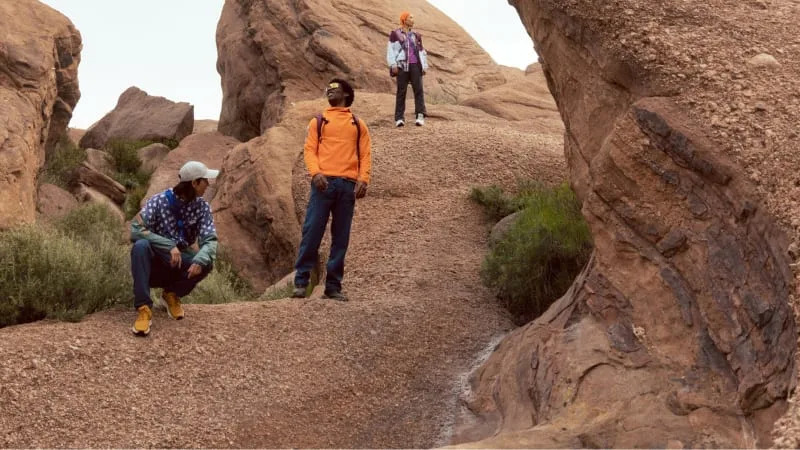
The North Face is synonymous with outdoor adventure and exploration. Known for its high-quality jackets, backpacks, and outdoor apparel, The North Face combines innovation with durability. REI's sales on The North Face gear are a golden opportunity to snag versatile products for your next outdoor escapade without breaking the bank.
Patagonia (Up to 61% off)

Patagonia is a pioneer in sustainable and eco-friendly outdoor clothing. Its commitment to environmental responsibility shines through in its products. Shopping for Patagonia gear at REI during sales not only gets you top-notch outdoor clothing but also aligns with those whose values align with supporting eco-conscious brands.
Arc'teryx (Up to 31% off)

Arc'teryx is revered for its technical precision and performance-driven gear. From lightweight jackets to rugged backpacks, its products are engineered for extreme conditions. REI's sales on Arc'teryx items are a chance to invest in gear that delivers uncompromising performance during your adventures.
REI Co-op (Up to 41% off)
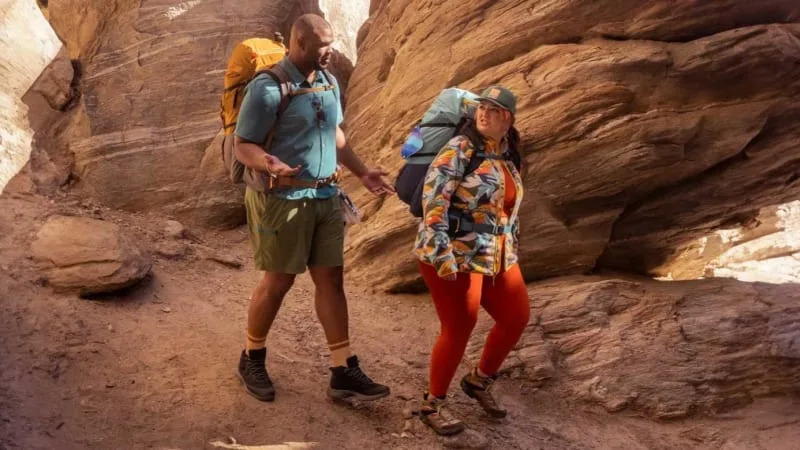
REI Co-op's in-house brand offers a wide range of outdoor equipment and clothing. Its products are designed with input from outdoor enthusiasts and are known for their reliability and affordability. Shopping for REI Co-op gear during sales allows you to support a brand that is deeply connected to the outdoor community.
Smartwool (Up to 60% off)

Smartwool is a go-to brand for high-quality, merino wool-based clothing and accessories. Their gear excels in moisture-wicking, temperature regulation and comfort. During REI's sales, you can score Smartwool items that provide the ultimate in comfort and performance, whether you're hiking, skiing, or just staying cozy in colder weather.
Marmot (Up to 60% off)

Marmot is a brand renowned for its durable and high-performance outdoor clothing and equipment. Whether you're an avid hiker or a winter sports enthusiast, Marmot's gear is designed to keep you comfortable in challenging conditions. REI's Marmot sale is the perfect time to invest in quality products known for their longevity and functionality while enjoying significant savings.
Mountain Hardwear (Up to 63% off)

Mountain Hardwear is all about pushing boundaries. Its innovative designs and technical gear cater to those who demand top-tier performance from their outdoor equipment. With REI's sales offering up to 71% off, you can get your hands on Mountain Hardwear gear that's perfect for your next adventure, from high-altitude climbs to rugged treks.
Outdoor Research (Up to 67% off)

Outdoor Research is a brand trusted by outdoor enthusiasts for its focus on versatile, high-quality clothing and accessories. Its gear is designed to adapt to changing weather conditions and various outdoor activities. At REI's sale, you can explore a wide range of Outdoor Research products, ensuring you're well-prepared for any adventure while enjoying significant discounts.
Prana (Up to 74% off)

Prana is known for its stylish and eco-conscious approach to outdoor and active wear. Its clothing is not only comfortable but also sustainable, making it perfect for those who care about the environment. REI's sale on Prana items allows you to upgrade your active wardrobe with comfortable, eco-friendly clothing at a fraction of the cost.
Hoka (Up to 32% off)

Hoka is a brand that revolutionizes the world of trail running and hiking with its ultra-cushioned, lightweight footwear. Perfect for those who need reliable and comfortable footwear for long treks or trail running. At REI's sale, you can discover Hoka shoes that will enhance your outdoor experiences while enjoying substantial savings.
More top picks
- Winter clothing essentials: Top cold-weather gear to keep you warm on your adventures
- Winter camping gear that'll help you embrace the cold
- The best cold weather essentials to keep in your car
- Turn your car into a comfortable camper for less than $100
Don't miss out on these incredible deals at REI's 4th of July Sale and Clearance event. Head to your nearest REI store or visit their website to take advantage of these limited-time offers and gear up for your next outdoor adventure.
- car camping
- License License
- Facebook Share
- Twitter Share
- Tumblr Share
- Twitch Share
- Flipboard Share
- Instagram Share
- Newsletter Share
- Youtube Share
- Feeds Share

Popular Vehicles
Popular new vehicles.
- 2023 Ford Bronco
- 2024 Toyota Tacoma
- 2024 Lexus GX 550
- 2024 Toyota RAV4
- 2024 Ford Bronco
- 2023 Toyota Camry
- 2023 Toyota Tacoma
- 2024 Ford F-150
- 2024 Chevrolet Trax
- 2024 Toyota Camry
Popular Used Vehicles
- 2021 Jeep Grand Cherokee
- 2022 Ford F-150
- 2014 Honda Accord
- 2014 Honda Civic
- 2022 Toyota 4Runner
- 2021 Toyota 4Runner
- 2014 Jeep Grand Cherokee
- 2018 Chevrolet Camaro
- 2022 Honda Accord
- 2022 Toyota RAV4
Popular Electric Vehicles
- 2023 Tesla Model 3
- 2024 GMC HUMMER EV Pickup
- 2024 Tesla Model 3
- 2017 Tesla Model S
- 2023 Lucid Air
- 2016 Tesla Model S
- 2022 GMC HUMMER EV
- 2024 Tesla Cybertruck
- 2022 Tesla Model 3
- 2023 GMC HUMMER EV Pickup
Popular Truck Vehicles
- 2024 Toyota Tundra
- 2024 Chevrolet Silverado 1500
- 2023 Ford F-150
- 2024 Chevrolet Silverado 2500HD
- 2024 Chevrolet Colorado
- 2023 Toyota Tundra
Popular Crossover Vehicles
- 2024 Chevrolet Traverse
- 2024 Buick Envista
- 2023 Toyota RAV4
- 2024 Subaru Outback
- 2023 Ford Bronco Sport
- 2024 Hyundai Tucson
Popular Luxury Vehicles
- 2024 Mercedes-Benz GLC 300
- 2024 Porsche 911
- 2022 Lexus IS 350
- 2024 Land Rover Defender
- 2014 Mercedes-Benz E-Class
- 2014 Mercedes-Benz C-Class
- 2019 Chevrolet Corvette
- 2024 Lincoln Nautilus
- 2024 Lexus RX 350
Popular Hybrid Vehicles
- 2024 Ford Explorer
- 2024 Toyota Sienna
- 2025 Toyota Camry
- 2023 Ford Explorer
- 2022 Ford Explorer
- 2024 Toyota Venza
- 2023 Toyota Sienna
Popular Makes
Featured makes, product guides.
- The Best Electric Bikes
- The Best Car Covers
- The Best Portable Air Compressors
- The Best Car GPS Trackers
Choose a Display Name
Please enter a display name

Sign in to post
Please sign in to leave a comment.

IMAGES
COMMENTS
August 18, 2017. • 11 min read. In 1951, a British explorer named Eric Shipton looking for an alternative route up Mt. Everest found a footprint that appeared to be hominoid. He took a picture ...
The Yeti (/ ˈ j ɛ t i /) is an ape-like creature purported to inhabit the Himalayan mountain range in Asia. In Western popular culture, the creature is commonly referred to as the Abominable Snowman.Many dubious articles have been offered in an attempt to prove the existence of the Yeti, including anecdotal visual sightings, disputed video recordings, photographs, and plaster casts of large ...
New research might finally answer the question of what the Yeti really is, however. A study published in the Proceedings of the Royal Society B yesterday seeks to shed light on the identity of the ...
The Yeti is a cryptozoological phenomenon popularized in the early 20 th century by British mountain explorers in the Himalayas. Those who claim to have seen it report a modest-sized, two-legged, hairy mountain creature with disproportionately large feet. Photograph of an alleged yeti footprint found by Michael Ward.
The Yeti is said to be muscular, covered with dark grayish or reddish-brown hair, and weigh between 200 and 400 lbs. (91 to 181 kilograms) It is relatively short compared to North America's ...
Now, reports Sarah Zhang at The Atlantic, some of the best of this evidence has been put to the test. And it turns out, most yeti samples actually come from brown bears. The latest tale began with ...
Now, DNA analysis of multiple supposed Yeti samples—including hair, teeth, fur, and feces—shows that the stories are based on real animals roaming the high mountains. The results, published ...
In many parts of the Himalayas, the yeti's existence is an accepted fact and one country, Bhutan, has even created a national park specifically to protect its natural habitat. 2. David ...
Science solves the mystery of the elusive Yeti. Link Copied! Scientists perform DNA tests on 'Yeti' samples (2017) Monster hunters who hoped science would prove the existence of the Yeti once and ...
The team sequenced the mitochondrial DNA of 23 Asian bears (including the Yeti samples) and compared it with other bears around the world. They found that Tibetan brown bears are closely related to American bears, but Himalayan bears belong to a different evolutionary lineage that split around 650,000 years ago, during a major ice age.
Sykes' research focused on two samples in particular, both from the Himalayas but found about 800 miles apart, one in the Ladakh region and the other in Bhutan. A footprint of Yeti, discovered ...
As part of the 1960-61 Silver Hut expedition led by Edmund Hillary, then the world's most famous mountaineer, Doig had come in search of a creature that, like a god, occupied the rarified air ...
The exact identity of the yeti, an ape-like creature, important to folklore and mythology in the Tibetan Plateau-Himalaya region is still surrounded by mystery. The authors of a recent Proceedings B article on the evolutionary history of brown bears used genetic analyses to show the phylogenetic relationships and evolutionary history of ...
Although Yeti research has been marked by several high-profile claims and reports over the past few years, the golden age of Yeti research most likely remains the 1950s. And that golden age likely began with the Shipton footprints. As interest in summiting Everest peaked in the years following World War II, the British led a reconnaissance expedition up the mountain in order to scout out plans ...
Of the nine purported yeti remains analyzed in a new study, eight of them (including the fragment of leg bone seen above) came from bears. Icon Films Ltd. Of the nine "yeti" samples, eight turned out to be from bears native to the area, the researchers report today in the Proceedings of the Royal Society B. The other sample came from a dog.
None reveal the existence of a yeti or Bigfoot, reports Bryan Sykes, an Oxford University geneticist well-known for his research on human evolution. But two hair samples point to a possible new ...
This paper provides a chec klist of 35 hypotheses concerning the identity of the yeti - a hairy. creature in Sherpa folklore, Tibetan literature, and cryptozoology. Most scientists dismiss the ...
The Future of Yeti Research. As technology advances, so do the methods available for searching for the Yeti, offering new hope to those convinced of its existence. DNA testing and environmental DNA (eDNA) analysis offer promising tools for identifying unknown species in the Himalayas.
In a report released yesterday, Randal Konik from Jefferies maintained a Buy rating on Yeti Holdings (YETI - Research Report), with a price target of $54.00. Randal Konik has given his Buy ...
10. 1 / 5. And so in August 2016, after more than two years of planning, Yeti opened its Innovation Center, a dedicated prototyping and product-development facility. The unmarked building sits in a corporate office park shared with an engineering lab, a few miles down the road from Yeti's headquarters in Austin, Texas.
Congress Asset Management Co. MA raised its stake in shares of YETI Holdings, Inc. (NYSE:YETI - Free Report) by 7.7% during the 1st quarter, according to its most recent filing with the SEC. The firm owned 790,900 shares of the company's stock after acquiring an additional 56,881 shares during the ... Several research firms recently issued ...
Yeti Rambler Vitals. The Rambler is a hefty-feeling stainless steel mug, sold in about a dozen shapes and in capacities ranging from 10 to 30 ounces, for $12 to $35. We tested the 20-ounce Rambler ...
The Drosophila Yeti gene (CG40218) was originally identified by recessive lethal mutation and subsequently mapped to the deep pericentromeric heterochromatin of chromosome 2. Functional studies have shown that Yeti encodes a 241 amino acid protein called YETI belonging to the evolutionarily conserved family of Bucentaur (BCNT) proteins and exhibiting a widespread distribution in animals and ...
Published 7:03 PM EST, Tue November 28, 2017. Link Copied! The 2001 movie "Monsters Inc." featured a Yeti who worked in the mail room. Pixar Animations Studios/IMDB. The Bumble plays the bad guy ...
By Advanced Research Computing (ARC) Decommissioned in 2023, Yeti was the first supercomputer available to all USGS research staff. Sources/Usage: Public Domain. View Media Details. (Credit: Jeff Falgout, USGS. Public domain.) Yeti Specifications. 39,166 Total Cores. 3,728 CPU Cores (1,456 Intel Ivy Bridge cores and 2,272 Intel Haswell cores)
YETI has no specific hour claims in relation to keeping water cold. However, for this review, I filled up both cups with water and added 12 ice cubes at noon on a Monday. Three hours later, the ...
The Yeti Roadie 15 Hard Cooler is the brand's most affordable hard cooler to date, and popular colors are already selling out just hours after its launch. It holds up to 22 cans or 16 pounds of ...
REI Co-op Members, save 20% on one full-price Yeti cooler Limited-time sale: Save on camping gear, bikes, clothing & more Up to 30% off camp kitchen & furniture: REI Co-op brand, MSR & more
Yeti just released a new set of summer colors for Rambler water bottles, tumblers, lunch boxes and more.